Artist’s Palate: recipes by your favourite artists and designers
Artists and designers serve up their prized dishes for our ongoing Artist’s Palate series, a delectable feast for the mouth as well as the eyes. From Cindy Sherman’s gnocchi to Karl Lagerfeld’s stuffed peppers and more, tuck into the Wallpaper* dining digest...

Leandro Erlich’s
Chimichurri
Leandro Erlich’s interactive installations have included an illusory swimming pool that allows visitors to walk underwater thanks to a well-placed layer of glass, and a pair of escalators seemingly knotted like a pretzel. The Argentine artist is soon to take over a stretch of Miami Beach with 100 car-shaped sand sculptures, then let the public claw them apart. His take on the asado (the classic Argentine barbecue) has a similarly participatory element, requiring a merry band of helpers, a roaring fire, a string of sausages, bread rolls, and a chimichurri prepared by his collaborator Raùl. To ensure the chimichurri doesn’t spill, the sandwich is best enjoyed, much like Erlich’s art, with the head tilted 90 degrees back. For the recipe, click here.
Linen napkins, £13 each, by The Conran Shop. ‘Eat.it’ spoon, £24, by Wiel Arets for Alessi. ‘Bloom’ salt cellar with spoon, £35, by Helle Damkjær, for Georg Jensen, from Amara. ‘Manhattan’ bowl, £60, by Georg Jensen. ‘Haversham’ fabric in Feather Grey, £30 per m, by Romo. Photography: Benedict Morgan. Interiors: Olly Mason. Food: Liam Baker. Writer: TF Chan

Rirkrit Tiravanija’s
Buñueloni
Twenty-five years since Rirkrit Tiravanija doled out free green curry to a voracious crowd at Manhattan’s 303 Gallery, food remains key to the Thai conceptual artist’s practice. He has partnered with gallerist Gavin Brown on a restaurant in upstate New York, chef Dalad Khambu on Berlin eatery Kin Dee, and fellow artist Tobias Rehberger on a food stall at Frankfurt’s Kleinmarkthalle. His twist on a Negroni substitutes Carpano Antica Formula vermouth for Campari. Topped with gin, ‘in sufficient quantity to ensure its dominance over the other ingredients’, Tiravanija’s creation ‘has excellent effects on the imagination. I’ve no idea how or why; I only know that it works.’ For the recipe, click here.
‘Glass Family’ glassware, from £6 each, by Jasper Morrison, for Alessi. ‘Revolution’ glassware, from £71, by Fferrone, from WallpaperSTORE*. ‘Essence’ carafes, £71 each, by Alfredo Häberli, for Iittala; ‘Tokio’ jugs, £28 each; ‘Tube’ jug, £14, both by Ichendorf Milano, all from SCP. ‘Grande Concrete Look’ floor tiles in Crete, €87 per sq m, by Marazzi. Photography: Baker & Evans. Interiors: Olly Mason. Food: Iain Graham. Writer: TF Chan

One beautiful evening in Venice, German artist Katharina Grosse came across a small restaurant called Alla Vedova (at the widow’s). Thinking immediately of Emilio Vedova, the late Venetian painter who had seen abstraction as a gateway to political freedom, Grosse imagined being invited to his table. ‘We had a lot of Venetian specialities that night, but nothing was like the dark purple-black inky, velvety linguine.’ The aftermath bore a delightful resemblance to Vedova’s work – energetic, expressive brushstrokes on largely monochrome canvases. The linguine ‘left traces everywhere on the plate, the paper tablecloth, my tongue and my teeth,’ recalls Grosse. ‘Eating squid ink pasta is as if biting into the sea at night.’ For the recipe, click here.
‘Aarne’ cocktail glass, £29, by Göran Hongell, for Iittala, from Skandium. ‘Tourron’ dinner plate, £25, by Jars; ‘Broadway’ fork, £10, by A for Amara, both from Amara. Photography: Philippe Fragnière. Interiors: Olly Mason. Entertaining Director: Melina Keays. Writer: TF Chan

Ulla von Brandenburg’s
Orangettes
From the Technicolor skateboard ramp at the heart of the Palais de Tokyo in 2012 to the seven monumental stage curtains at this year’s Art Basel Hong Kong, German artist Ulla von Brandenburg’s work is always theatrical. ‘Sweet Feast’, a new project for London’s Whitechapel Gallery, was inspired by a 1973 exhibition of European sweets that was abruptly halted when a group of children devoured the exhibits. Mobilising 100 primary school pupils, von Brandenburg has created a video re-enactment of the event as a discussion of Britain’s changing relationship with the EU. Her contribution to our artist’s recipe series is naturally a sweet treat – orangettes, made from whole discs of orange rather than just the peel. Dig in. For the recipe, click here.
Marble platter, £51, by Serax, from Amara. ‘Stop’ bookends, from £87, by Philipp Mainzer, for E15, from Viaduct. Eames chair, £125; Prouvé chair, £195, from the Miniatures Collection, by Vitra Design Museum, from Vitra. ‘Norr’ floor tiles, price on request, by Mirage. Fabrics, by Villa Nova and Romo. Photography: Philippe Fragnière. Interiors: Olly Mason. Entertaining Director: Melina Keays. Writer: TF Chan

Christian Loboutin’s
Salmorejo

Alicja Kwade’s
Green papaya salad
Everyday objects laden with metaphor, linear objects drooping against walls, and mirror images with deliberate imperfections lend a hallucinatory quality to the works of Alicja Kwade, unsettling our understanding of science and the meaning of reality. In happy contrast, her dish of choice is a simple green papaya salad. ‘The first time I made it was during an artist residency for L’Association Martiniquaise pour l’Art Contemporain in Martinique,’ she says. ‘Their small boathouse is the most beautiful place on earth I know.’ For the recipe, click here.
‘Unity’ quarter circle trays, £35 each, by AYTM. ‘Binic’ lamp, £132, by Ionna Vautrin, for Foscarini. ‘Giro’ fork and knife, £10 each, by UNStudio/ Ben van Berkel, for Alessi. Photography: Baker & Evans. Interiors: Maria Sobrino. Food: Liam Baker. Writer: TF Chan

Joana Vasconcelos’
Fruit cake
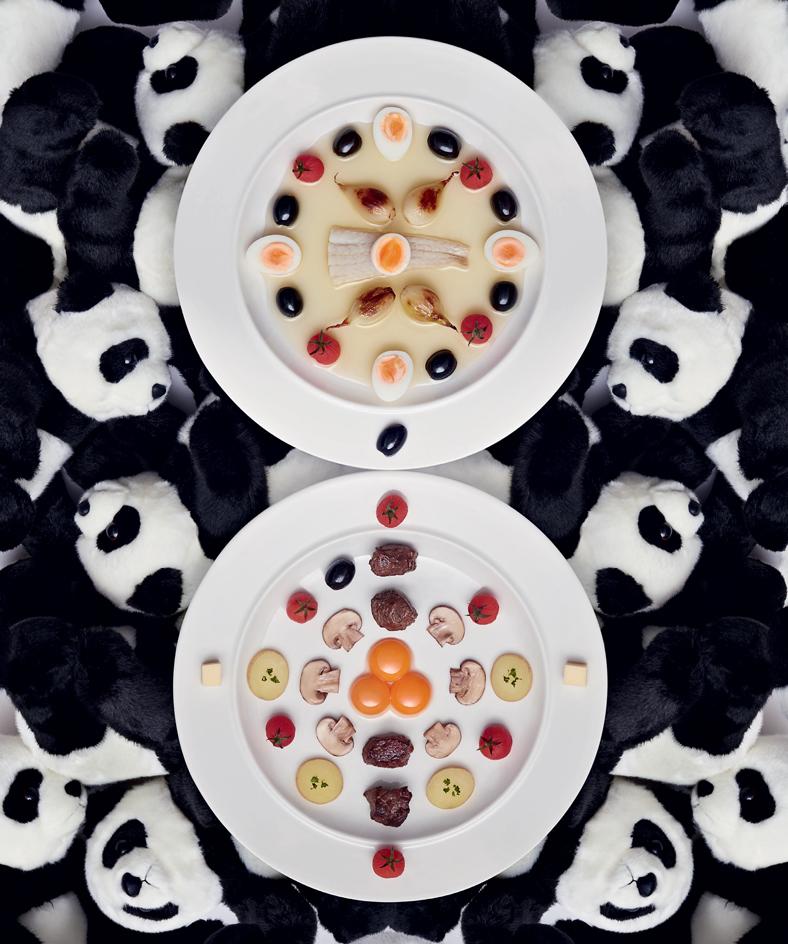
Campana Brothers’
Surf and turf

Tomás Saraceno’s
Chocolate nut cake

Kenzo Takada’s
Miso soup
Almost five decades after he burst onto the fashion scene with Japanese-inspired, audaciously patterned textiles, Kenzo Takada continues to draw inspiration from his home country – last year festooning Roche Bobois’ ‘Mah Jong’ sofa in kimono-like jacquard patterns, and developing cushions and vases to match. Like the designer himself, his recipe is the pride of Japan. ‘I love miso soup,’ he declares. ‘It’s a mix of complexity and simplicity. It is easy to eat, and can accompany many foods, or simply be served with a bowl of rice.’ For the recipe, click here.
Pictured: archive print, from the Kenzo S/S86 menswear collection. ‘Krenit’ bowl (seen digitally enhanced), £30, by Herbert Krenchel, for Normann Copenhagen, from Skandium. Photography: John Short. Interiors: Matthew Morris. Food: Liam Baker. Writer: TF Chan

Spencer Finch’s
Almond chocolate cookies
The skies have a strong hold on the imagination of American artist Spencer Finch, who once hand-painted 2,983 squares of paper in varying shades of blue to approximate the colour of the heavens on the day the Twin Towers fell. A permanent fixture of New York’s 9/11 memorial, Trying To Remember the Color of the Sky on That September Morning is perhaps Finch’s most viewed artwork to date. However, that accolade may soon pass to A Cloud Index, a commission for the Crossrail station at London’s Paddington, to be unveiled in December 2018. A 120m-long glass canopy stretching above the concourse will be printed with cloud formations in the tradition of English landscape paintings. Like Finch’s contribution to our recipe series, it’s the perfect antidote for a dull wintry day. Of these cookies, which his great aunt Edna used to serve on Christmas Eve, Finch says, ‘They are not too sweet and not too chocolatey, but rich and wonderful.’ For the recipe, click here.
Pictured: ‘Tangram’ crystal bowls, price on request, by Jan Čtvrtník, for Moser. ‘Pietra di Vals Grigio’ tiles, price on request, by Marazzi. Photography: John Short. Interiors: Olly Mason. Food: Peta O’Brien. Writer: TF Chan
Wallpaper* Newsletter
Receive our daily digest of inspiration, escapism and design stories from around the world direct to your inbox.

Gillian Wearing’s
Lentil, potato and leek soup
In the two decades since she won the Turner Prize, Gillian Wearing has placed family at the heart of her work, such as her series of self-portraits in which she dons eerily realistic silicone masks resembling her own relations. So it comes as no surprise that Wearing has selected a hearty family dish for us. ‘My favourite dinner when I was a child was my mother’s vegetable soup,’ she says. The original recipe called for lamb, but having been vegetarian for many years, she finds this meat-free variation ‘fills that nostalgic food gap’. For the recipe, click here.
Pictured: concrete bowl, £114 for set of three, by Stephan Schulz, for Helena Leba Softes, from Twentytwentyone. ‘Rundes Modell’ spoon, £126 for set of six, by Josef Hoffmann, for Alessi. ‘Bahama CS’ fabric, £102 per m, by Nya Nordiska. Photography: John Short. Food: Iain Graham. Writer: TF Chan

Bernar Venet’s
Oeuf caviar
Bernar Venet’s Corten steel sculptures have created dramatic statements at Versailles, Nice, New York and, most recently, in the grounds of Cliveden in Buckinghamshire. Their elegant forms reflect a lifetime of careful study. ‘They take 65 years to consider, then it’s eight minutes to build the maquette, and up to three months to make them,’ he says. His oeuf caviar is equally considered: two elementally similar yet visually opposite ingredients, arranged in perfect harmony. It’s his dish of choice at the Michelin-starred Les Gorges de Pennafort, run by his friend Philippe Da Silva and located near Venet’s art foundation in Provence. Venet is fond of the dish’s simplicity. ‘It’s quick and visually sober, like my artwork.’ For the recipe, click here.
Pictured: red granite plate, £87, by Willer. ‘Terrazzo’ platter, £69, by Serax, from The Conran Shop. Dinner fork, £15, by Louise Campbell, for Georg Jensen. ‘Mystone Bluestone’ tile in Grigio, from £41 per sq m, by Marazzi. Photography: Felicity McCabe. Interiors: Maria Sobrino. Food: Maud Eden. Writer: TF Chan

Manolo Blahnik’s
Bread and butter pudding
Manolo Blahnik is perhaps the high-kickingest shoemaker of our time. So it’s fitting he’s being feted in an upcoming film, the most hotly anticipated fashion documentary since Dior and I. It promises an intimate portrait of the designer, including the tale of how, growing up in the Canary Islands, Blahnik used sweet wrappers to craft shoes for the lizards in his garden. His contribution to our artist recipe series, a bread and butter pudding, comes with an expectedly elegant twist. It’s made from two-dayold brioche and layered with raisins soaked in either rum or marsala wine. For the recipe, click here.
Pictured: ‘Fred’ desk, £5,760, by Roberto Lazzeroni, for Poltrona Frau. Glasses, £125, by Cubitts. Imporium pen, £325, by Mario Bellini, for Lamy. ‘Anmut Platinum’ plate, £26, by Villeroy & Boch, from Harrods. ‘Goa’ fork, €11, by Cutipol. Notebooks, from a selection, by Hieronymus. ‘Tizio’ light, £250, by Richard Sapper, for Artemide. Winsor & Newton inks and pen, part of set, £250, from Linley. ‘Phi’ scissors, £25,by Hay, from SCP. Fossilised ammonite, £350, from Dale Rogers Ammonite. ‘Soda’ fabric in Wine, £60 per m, by Kirkby Design. Photography: Felicity McCabe. Interiors: Maria Sobrino. Food: Maud Eden. Writer: TF Chan
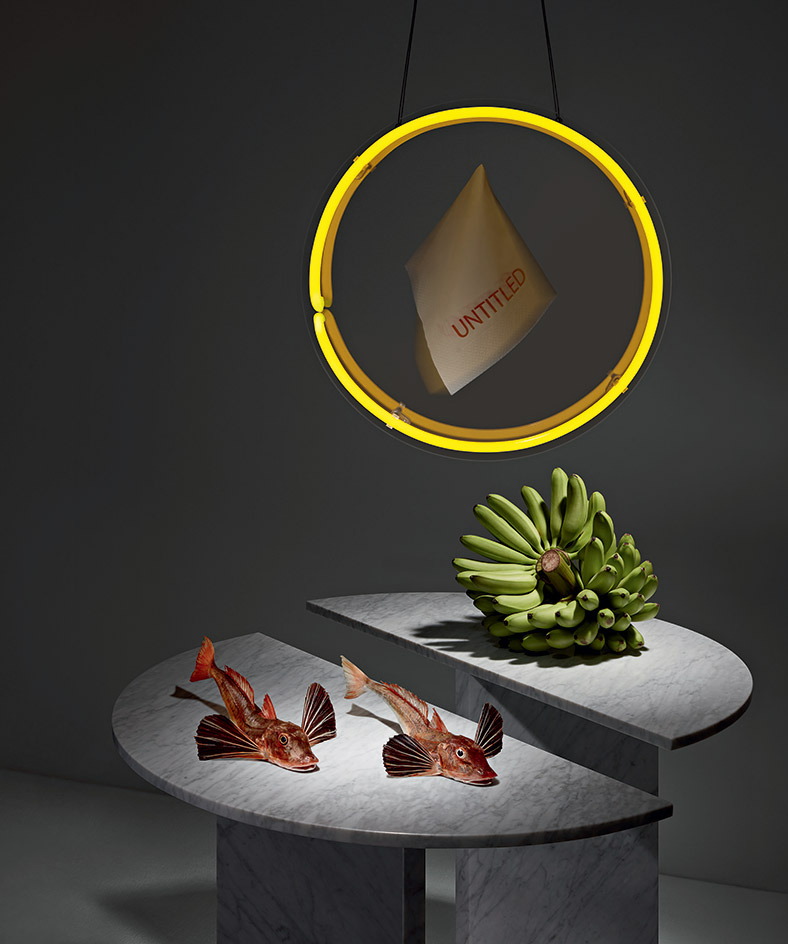
Langlands & Bell’s
Braised gurnard with patacones
British artists Langlands & Bell have worked together for four decades, producing quietly provocative works ranging from monochrome sculptures to an interactive animation of Osama bin Laden’s house (which earned them a Turner prize nomination in 2004). Like their partnership, their recipe of choice is an ingenious pairing – this time between gurnard, a prehistoric-looking fish, and patacones, fried slices of bananas or plantains. ‘It’s based on meals we have eaten in Cartagena, Colombia, where fish and bananas of many kinds are regularly eaten together,’ they explain. Often prepared at Untitled, a modernist summer retreat of their own design in the Kent Weald, the dish is served with typographic napkins – a housewarming gift from architect Amanda Levete – and best paired with ‘a light beer, a dry Biddenden’s cider, or a Sauvignon blanc’. For the recipe, click here.
Pictured: neon circle, £325, by Steve Earle, for Kemp London. ‘Split A’ table, £2,230, by Nendo, for Marsotto Edizioni, from Twentytwentyone. Photography: John Short. Interiors: Olly Mason. Food: Peta O’Brien. Writer: TF Chan

Mark Titchner’s
Scrying crackers with yeast extract
Twelve months after the Brexit vote, mandarins in Downing Street and Brussels are tackling the question: ‘What now?’ Mark Titchner – the 2006 Turner Prize nominee behind installations comprising existential koans like Why is there something instead of nothing? – may have the answer. He turned to John Dee, Elizabeth I’s advisor, who used an obsidian mirror to peer, or ‘scry’, through time. ‘We are trying to discern the post-Brexit future with a reflective “scrying bowl” of yeast extract,’ says Titchner. ‘Which is probably higher tech than what the Tories are planning!’ For the recipe, click here.
Pictured: ‘Dauville Charcoal’ small plate, £42 for set of four, by Canvas Home, from Amara. Horn butter knife, £11, by Hornvarefabrikken, from SCP. Photography: John Short. Lifestyle: Emma Moore. Food: Peta O'Brien. Writer: Daven Wu

Tokujin Yoshioka’s
Wagashi
In the world of Japanese artist and designer Tokujin Yoshioka, glass chairs suddenly disappear when wet, and swirling clouds turn out to be drinking straws. His work defies definition, a legacy perhaps of the 20-odd years he has spent working with Issey Miyake. But there is warmth and wonder in his work, as witnessed in ‘S.F_Senses of the Future’, his collaboration with LG at the 2017 Salone del Mobile. Whet your appetite with his favourite treat, wagashi, Japanese sweets that have evolved into an art form. For the recipe, click here.
Pictured: ‘Invisible’ table, £345, by Tokujin Yoshioka, for Kartell. Photography: John Short. Interiors: Matthew Morris. Food: Peta O'Brien. Writer: Daven Wu
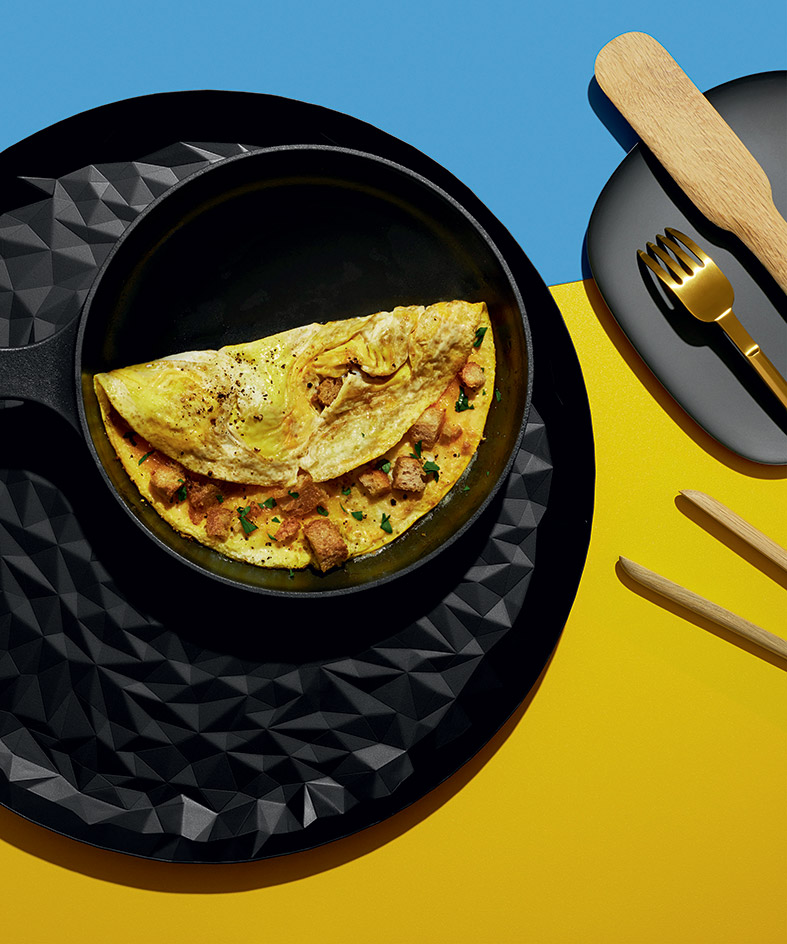
Xavier Veilhan’s
Crouton omelette
Through sculpture, photography and painting, French artist Xavier Veilhan transforms the mundane into something arresting. His 2009 sculpture of steel horses galloping across the cobblestones of Versailles displays not just a firm grasp of history and drama, but also of anatomy and the physics of motion. This sense for the transformative is also evident in the kitchen. His crouton omelette is based on nothing more than day-old bread and yet it is, he says, ‘the most comforting, the kind of dish you prepare on Sunday evenings when there’s nothing left in the fridge’. Nothing except imagination. For the recipe, click here.
Pictured: ‘Joy No.3’ tray, £70, by Claudia Raimondo, for Alessi. Pan, £95, by Barnaby Tuke, for Crane Cookware. Table, £820, by Fritz Haller, for USM. ‘Namasté’ plate, £92 for three, by Jean Marie Massaud, for Kartell, from Amara. Fork, ‘41’, by Koichi Futatsumata, for Valerie Objects. ‘Easy’ tools, from £8, by Cecilie Manz, for Rig-Tig, from Skandium. Writer: Daven Wu

Viviane Sassen’s
Artichokes with vinaigrette
Dutch photographer Viviane Sassen has never been one for conventions. Her career is remarkable for its restless energy, especially in its blurring of the lines between fashion photography and art. Her images offer glimpses of unguarded moments in the lives of her subjects – backs are often turned as if to protect a secret or the attention has been diverted to something happening off-camera. As we noted in our piece on Sassen’s ‘Pikin Slee’ (W*192), a moving documentary of a village in the Suriname rainforests, she ‘approaches her subjects almost like a sculptor who knows that light and shadow can create spaces’. Ironic, then, that one of her favourite dishes of artichokes and vinaigrette – always eaten on her birthday – is filled with such sunny flavours. ‘Don’t forget to eat the hearts,’ she says. For the recipe, click here.
Pictured: ‘Les Brothers’ mirror, £375, by Paolo Cappello, for Miniforms, from The Conran Shop. Marble bowl, £16, by Broste Copenhagen,= from Goodhood. ‘Highland Falls 4’ matt emulsion, £24 per 2.5 litres, by Dulux. Photography: Philippe Fragniere. Interiors: Olly Mason. Food: Matthew Ford. Writer: Daven Wu
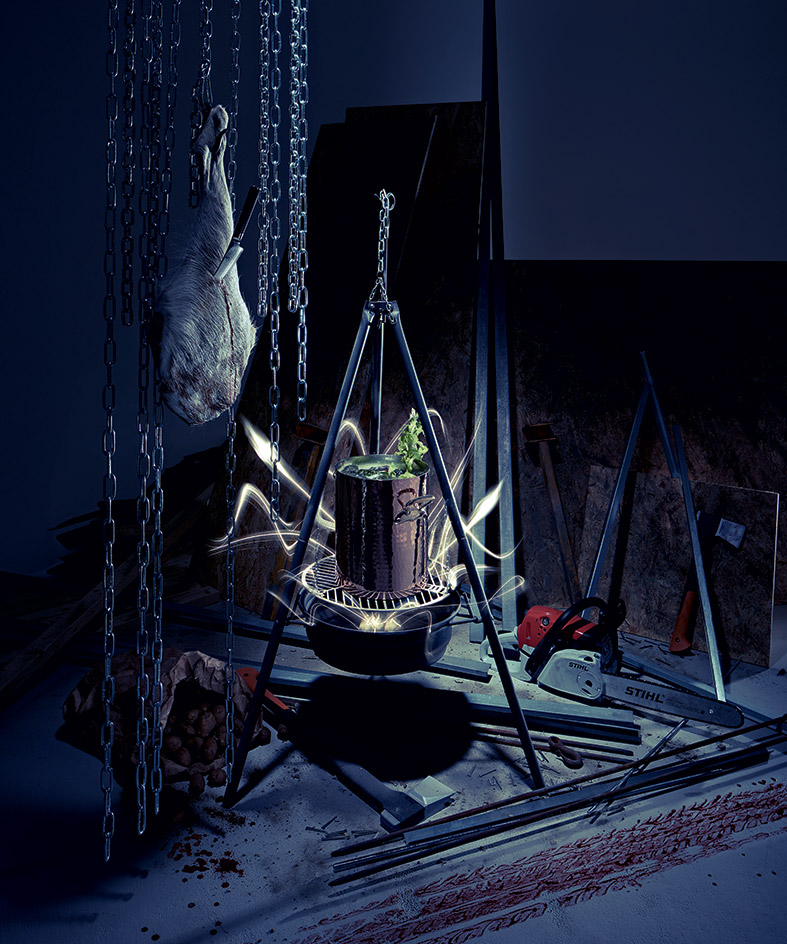
Conrad Shawcross’
Roadkill Scottish venison and juniper berry stew

John Baldessari’s
Polenta, spinach, eggs and bacon
John Baldessari has long incorporated elements of consumption into his work. Sometimes this has manifested itself in a figurative sense, such as his early 1967 piece A Two-Dimensional Surface Without Any Articulation Is A Dead Experience, in which he allowed his words to be painted by sign-painters. Sometimes the artist has approached the idea in a literal way – perhaps best exemplified by his Cremation Project, in which he burnt all his paintings from 1953 to 1966 and baked the ashes into cookies, which were displayed with a recipe. This provocative display of metarealistic gastronomy has been toned down in Baldessari’s contribution to the Wallpaper* dining digest. His recipe is a homey amalgam of familiar tastes and textures, proving once again that, even at 85, Baldessari still has a few tricks up his sleeve. For the recipe, click here.
Pictured: ‘Crockery’ jug, £75, by Max Lamb, for 1882, from SCP. Silver plate, £105, by Zanetto, from Harlequin London. Spoon, £65 for six-piece cutlery set, from Native & Co. ‘Lucio’ fabric in Steel, £48 per m, by Anthology, for Harlequin. Photography: John Short. Writer: Daven Wu

Michael Riedel’s
Alphabet soup
Given Michael Riedel’s punchy way with graphics and repeated forms, experiments in multiple media and the satellite acolytes and collaborators in his orbit, comparisons with Andy Warhol are inevitable. At his huge studio in Frankfurt he hosts a weekly communal dinner for artists, dancers, musicians, art collectors and designers, so his recipe is for a rewardingly fertile dinner party starter. ‘I like the idea of alphabet soup because, in my work, I use words in a way that have lost their original purpose,’ he says. ‘I’m producing text, but I’m not expecting anyone to read it. Eating alphabet soup is like putting words back into your mouth. It’s like reading backwards in a random order.’ For the recipe, click here.
Pictured: ‘Scandia’ spoon, £8, by Kaj Franck, for Iittala, from Skandium. Charger, £85, by Jaune de Chrome. ‘Embassy’ champagne saucer, £12, by David Mellor. ‘Colombina’ placemat, £32, by Doriana and Massimiliano Fuksas, for Alessi. Dom Pérignon Vintage 2006 limited edition, £155, by Michael Riedel, from Harrods. Photography: John Short. Interiors: Olly Mason. Food stylist: Peta O’Brien. Writer: Stephen Armstrong

Not Vital’s plain in pigna
Plain in pigna
The famously peripatetic Swiss artist Not Vital has worked in such locations as Beijing, Rio, Agadez and Bataan, but maintains close ties with his native Engadin, an Alpine valley famed for its wintry charms. This is evident from the subjects of his sculpture (snowballs encased in glass, a marble sled, an outsized cow’s tongue in stainless steel), his faithfully monochrome palette, and his eponymous foundation, dedicated to preserving the cultural assets of the region. It’s only natural that Vital would give us a traditional dish of grated potatoes, bacon and salsiz sausage. Its name, plain in pigna, means ‘full in the oven’ in his native Romansh. On the use of butter, he offers some sage advice: ‘Don’t be too hard on yourself, it’s one of the most important components.’ For the recipe, click here.
Pictured: ‘Caja Caja’ bowls, price on request, by Anna Torfs, from Harlequin London. Gratin dish, £70, by Le Creuset. ‘Odeon’ form, £11, by David Mellor Design. Photography: Felicity McCabe. Interiors: Matthew Morris. Food: Ian Graham. Writer: TF Chan

Cold soba
Daniel Arsham’s
In 1996, when Wallpaper* was born, a teenage Daniel Arsham was, he recalls, busy ‘listening to hip hop and taking a lot of photos on a Pentax K1000’. Two decades on, his witty experiments with structures encompass architecture, art and performance spaces. He is co-founder of the art/architecture studio Snarkitecture, while his works in sculpture and in set design for leading contemporary dancers have been shown around the world. ‘I’ve exhibited and worked in Japan for years,’ he says. ‘My wife is half Japanese. It’s my favourite place on earth. One of my favourite dishes from Japan is cold soba. The summers there can be quite hot and this dish is served cold. I like to make it even colder.’ For the recipe, click here.
Pictured: ‘Dolomyth’ block, price on request, by Alcarol, from Mint. ‘Matrix’ bowl, €30, by Bartek Mejor, for Vista Alegre. Pyrite clusters, prices on request, from Dale Rogers Ammonite

Beans on toast
Paul Smith’s
Sir Paul Smith has built a global empire and one of Britain’s most successful fashion brands through hard work, creativity and making the ordinary extraordinary. He takes the same approach to his favourite dish. While resolutely British, it is anything but ordinary and is tricked up with a twist – in this case, the world’s most famous sourdough and Echiré butter. ‘I’m not much of a cook but I do love classic, simple dishes. My recipe for beans on toast is exactly that. I’m close to the Poilâne family and always visit their bakery when I’m in Paris. They make the best bread in the world, so you start there and work up – perfect French butter combined with Heinz baked beans and a dash of HP sauce.’ It’s Paul Smith at his best – combining the best of British with international flavours. For the recipe, click here.
Pictured: ‘Swirl’ rug, £4,939, by Paul Smith, for The Rug Company. ‘Signature Stripe II’ dinner plate, £105, by Paul Smith, for Thomas Goode. Photography: John Short. Food stylist: Jennifer Joyce. Writer: Paul McCann

Chicken livers with pear
Polly Morgan’s
That offal (in this case, chicken livers served rare) appears in contemporary taxidermist Polly Morgan’s favourite recipe should not be much of a surprise. For the artist’s work includes, among the stunning coiled snakes on plinths and members of the finch family slumped around picture frames, Myocardial Infarction (2013), featuring five lovebirds feasting on a resin heart, its blood dripping down a white display stand. After all, someone whose freezer may, at times, contain four years’ worth of garden birds, a cormorant and a chimp, and who knows how to skin a baby giraffe, is unlikely to be fazed by a hint of pink in the middle of her chicken livers. For the recipe, click here.
Pictured: ‘Touch Me’ rug, £195 per sq m, by Stepevi. ‘Mami’ small bowl, £16.50, by Stefano Giovannoni, for Alessi. ‘Whitework No. 30’ Irish linen cocktail napkin, £65, by Gayle Warwick. Photography: Stephen Lenthall. Interiors: Benjamin Kempton. Entertaining director: Melina Keays. Writer: Paul McCann

Chicken tagine with olives and pickled lemon
Ron Arad’s
Ron Arad’s home town of Tel Aviv is host to any number of top-notch couscous shacks, and depending on your chef’s Maghreb heritage, the couscous will be as fine as sand or plump as nuts. However, despite these examples of what is possible, Israeli home-cooked chicken and couscous often includes packet stock powder that is salty enough to act as an emetic. Not so the famously hat-wearing designer’s recipe. He sticks to one chicken, the peel from one-and-a-half preserved lemons, saffron and olives, plus some herbs and spices. No stock powder. The tagine takes just over an hour. To do his homemade preserved lemons properly takes at least three weeks. You may want to plan ahead. Or buy a jar. For the recipe, click here.
Pictured: ‘Red or White’ glass, £80 per pair, by Ron Arad, for Nude. Tagine, £175, by Le Creuset. Photography: John Short. Interiors: Matthew Morris. Food: Peta O'Brien. Writer: Paul McCann

Sole with homemade mayonnaise
Andreas Gursky’s
Andreas Gursky, whose photographic landscapes famously take in the Rhine, rave culture and North Korea’s Arirang mass games, is as meticulous in the digital transformation of his art as he is in the creation of his mayo. He cooks his sole simply: in butter in a cast-iron pan. His vegetables are just steamed broccoli and boiled potatoes. But the devotion goes into the mayonnaise. An egg yolk, sea salt, mustard and good quality olive oil are mixed by hand, then he swaps to a lighter oil so the mayo isn’t too ‘olivey’. All whipped up in his Herzog & de Meuron-designed studio-apartment. For the recipe, click here.
Pictured: Gurksy’s sole in-situ on ‘USM Haller’ modular shelving, £1,676, by USM. Interiors: Evelina Kleiner. Food: Lotten Sundgren. Photography: Carlk Kleiner. Writer: Paul McCann

Stuffed peppers and tomatoes
Karl Lagerfeld’s
In the seven years that this page has recorded the recipes of the world’s leading artists and designers, this is the first time we’ve heard from a creative polymath whose wide range of endeavours actually includes a book of recipes. In 2005, art-fashion colossus Karl Lagerfeld published The Karl Lagerfeld Diet, which was notable for including quail and wine and for the honesty of its author, who admitted he lost weight to look good in clothes designed by Hedi Slimane. It was a bestseller in France, where they also like to look good in clothes. For his favourite recipe of stuffed peppers, Lagerfeld follows the strictures of his diet book and the focus is on lean protein and plenty of vegetables. And if you really want to do things the Lagerfeld way, have your personal chef prepare the dish for you. For the recipe, click here.
Pictured: ‘Vertigo’ round tray £1,195; rectangular tray £1,145, both by Christofle, from Thomas Goode. ‘Mini Papilio’ armchair, £1,008, by Naoto Fukasawa; ‘P60’ ottoman, £1,022, by Antonio Citterio, both for B&B Italia. Champagne coupe, £92, by Karl Lagerfeld, for Orrefors. Gloves, sunglasses and rings, from Chanel archive. Clutch, £125, by Karl Lagerfeld. Cufflinks, from £450, by Dior Homme. Necklace, £15,703, by Shamballa Jewels. Rings, from £195, by Chrome Hearts. ‘Mimi Stripe’ wallpaper, £34 per roll, by Harlequin. Photography: Gustav Almestål. Interiors: Maria Sobrino. Food: Henrietta Clancy. Writer: Paul McCann
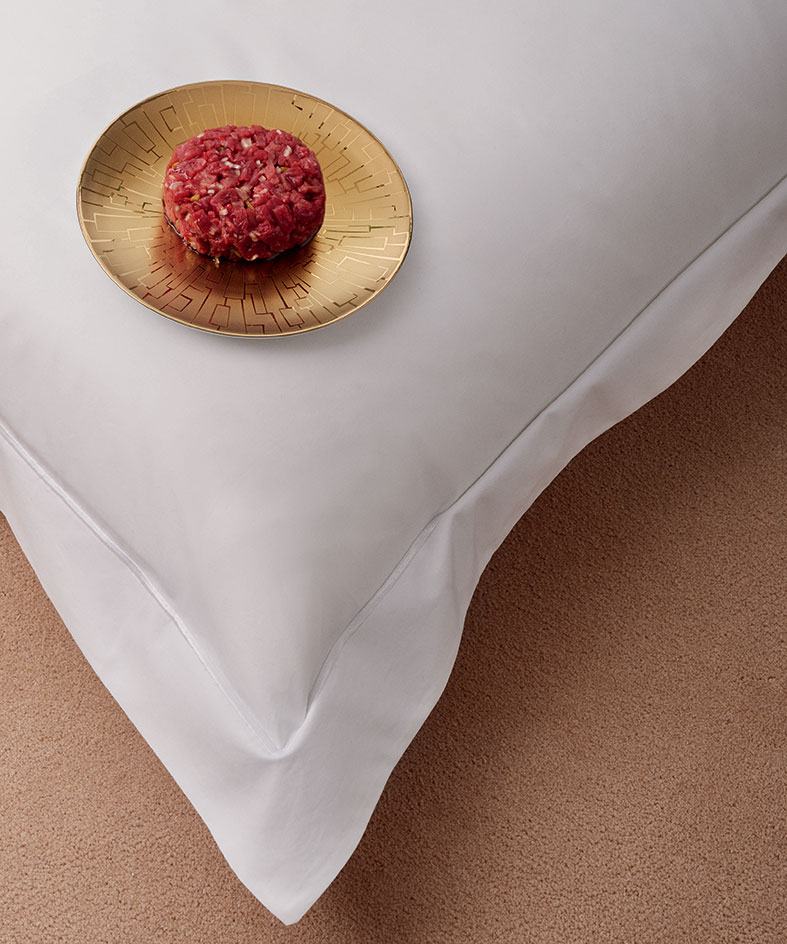
Steak tartare
Prem Sahib’s
Prem Sahib is having a moment. Last year, just two years after leaving London’s RCA, he had a solo show at the ICA. Meanwhile, his club night collaborations with artists George Henry Longly and Eddie Peake have earned him a place on the kind of mover-and-shaker lists that the London media adores. His artworks exude a cool minimalism with fleshy undertones, from pressed puffer jackets in seeming embrace to studded tiles pierced like skin. Cool and fleshy are also apt words for his favourite recipe. His version of steak tartare is influenced by his Polish-Sikh heritage and includes tinned sardines rather than anchovies (a holdover from Communist era austerity?) and chopped ogórek kiszony, better known outside Poland as a gherkin. He also likes a few drops of Maggi seasoning sauce. Piquant, cool and fleshy, just like the best club nights. For the recipe, click here.
Pictured: ‘TAC Gropius’ small plate, €29, by Rosenthal. Eco-Soft Deluxe pillow, £300; pillow case, £30, both by Hästens. ‘Majestic’ carpet in Antique Silk, £100 per sq m, by Brintons. Photograph: Gustav Almestál. Interiors: Matthew Morris. Writer: Paul McCann
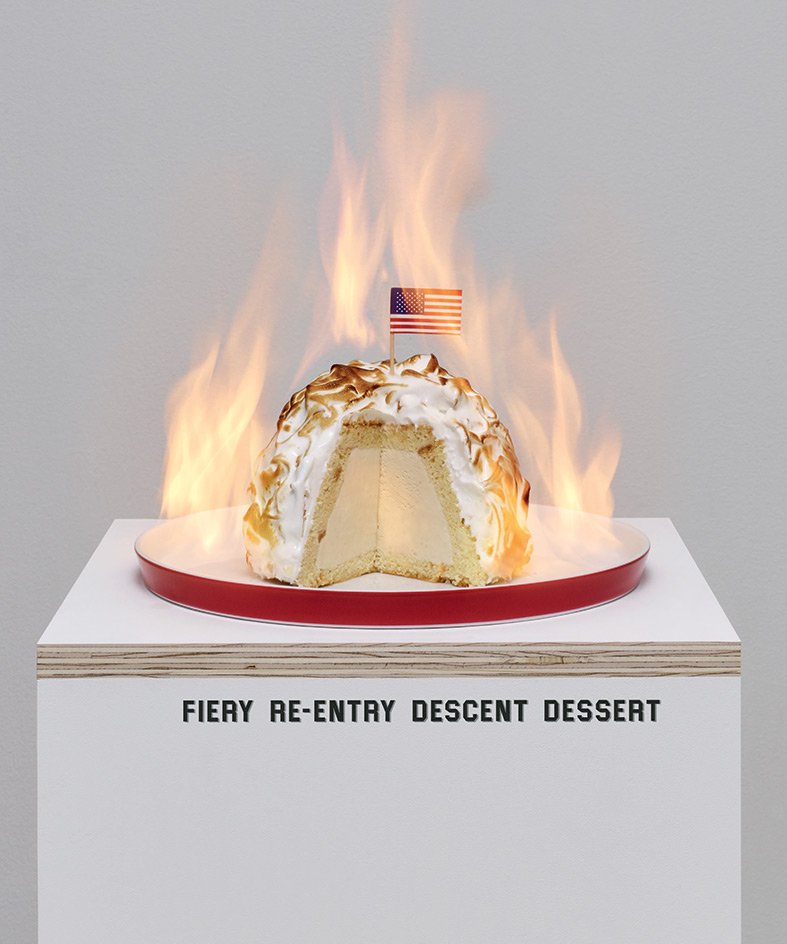
Tom Sachs’
Baked Alaska
Among the sculptor Tom Sachs’ cultural appropriations, remixes and samplings (such as a McDonald’s on wheels, a cardboard Chanel chainsaw and an Unité d’Habitation cut from foamcore), space exploration, in its Cold War pomp, has remained a constant. In 2007, his exhibition ‘Space Program’ included a scale-model lunar landing module and a mission control with dozens of video monitors. His sculptural borrowings are never quite perfect, so that he can show his working – and get to place a vodka bar in the Lunar Excursion Module. His take on a Baked Alaska, the Fiery Re-entry Descent Dessert, is proof we should ask more space-obsessed sculptors for their fave recipes. He suggests Sara Lee all-butter pound cake to form the insulation tiles and has Bacardi 151 providing the pyrotechnics. Best served wearing Tyvek space mittens. For the recipe, click here.
Pictured: ‘Sunny Day’ plate, €30, by Thomas, from Rosenthal. Photography: John Short. Entertaining director: Melina Keays. Interiors: Matthew Morris. Writer: Pei-Ru Keh

Alberto Alessi’s
Ass-burning chicken
As the president of the design firm that bears his family’s name, Alberto Alessi has been the force behind the company’s most recognisable creations. Since taking the helm in 1970, he has enlisted an impressive roster of big-name designers to conceive tableware under the Alessi name. Under his tenure, it is now possible for anyone to own a piece by Ettore Sottsass, Naoto Fukasawa or Philippe Starck, whose quirky, humour-infused creations have come to define the company’s reputation. One can only imagine how the name for Alessi’s self-professed ‘ass-burning’ chicken recipe came about. Made with Mexican dried black peppers and doused in sweet wine, it exemplifies Alessi’s daring approach to design and a taste for the good life in every bite. For the recipe, click here.
Pictured: ‘Tau’ tray, £148, by Kristiina Lassus; ‘PlateBowlCup’ soup bowl, £5.50, by Jasper Morrison; ‘Tonale’ beaker, £8.50; carafe, £19, both by David Chipperfield; condiment set (salt, pepper and toothpicks), £67, by Ettore Sottsass, all for Alessi. Photography: Gustav Almestål. Entertaining director: Melina Keays. Writer: Pei-Ru Keh

Carlos Cruz-Diez’s
Coloured soups
Few artists have explored the possibilities of colour as comprehensively as Venezuelan Carlos Cruz-Diez. A pioneer of the kinetic and op art movements, he has dedicated his 60-year career to dissecting the notion of colour through experiments with different wavelengths of light. His extensive output ranges from paintings and sculptures to installations and even pedestrian crossings. Now aged 92, Cruz-Diez reveals a love for fundamentals by sharing his menu for a week's worth of comforting soups. With a different colour for each day of the week, he proves himself to be a purist through and through. For the recipe, click here.
Pictured: a week of coloured soups, clockwise from top right: Monday, spinach; Tuesday, cream of squash; Wednesday, pea; Thursday, strawberry gazpacho; Friday, black bean; Saturday, Venezuelan celery; Sunday, red cabbage.'Krenit' bowls, £73 each, by Herbert Krenchel, for Normann Copenhagen, from Skandium. 'Nolly' table, £538, by Evangelos Vasileiou, for Ligne Roset. Photography: John Short. Interiors: Maria Sobrino. Writer: Pei-Ru Keh
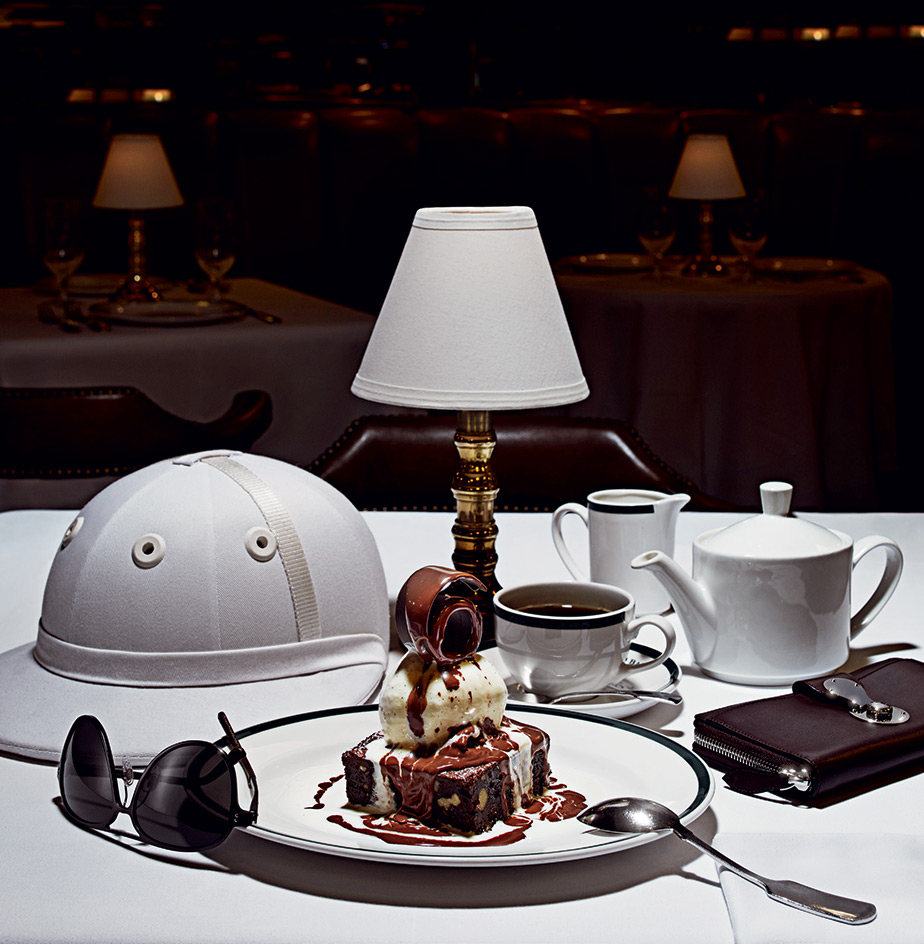
Ralph Lauren’s
The Polo Bar brownie
There’s no doubt that Ralph Lauren is an arbiter of classic American style, and now the same can be said about classic American cuisine, too. Since opening The Polo Bar in New York City at the end of last year, Lauren has been responsible for one of the hottest tables in town. Many of the restaurant’s comforting yet elevated dishes, such as Maine lobster roll, crab cakes and a well-laden corned beef sandwich (Mr Lauren’s personal favourite), have been vetted by the designer himself. No surprise then that the restaurant’s eponymous brownie is Lauren’s dish of choice to share. Made with decadent Valrhona chocolate and topped with vanilla ice cream and chocolate sauce, it embodies the wholesome yet indulgent ethos that the iconic designer stands for. For the recipe, click here.
Pictured: Sunglasses, £130; ‘Ricky’ zip-around wallet, £550, both by Ralph Lauren Collection. Polo hat and all tableware, from The Polo Bar, New York. Photography: Junichi Ito. Producer: Michael Reynolds. Writer: Pei-Ru Keh

Recipe cards and box
Moynat, James Cropper, and Baddeley Brothers’
Since 2009, in a tribute to Artists' Cookbook, published by MoMA in 1977, our back page has been dedicated to the favourite recipes of the world's greatest artists. For our Salone extravaganza, we invited James Cropper and Baddeley Brothers to create some recipe cards, and tasked luxury leather expert Moynat with crafting a sophisticated case to display the collection. Its bespoke case, made from slate grey leather, is inlaid with a blue leather asterisk, using Moynat's exceptional expertise.
Photography: John Short. Writer: Rosa Bertoli

Pasta with sea urchin
Paola Pivi’s
Wildlife is a recurring ingredient for Italy-born, Alaska-based multimedia artist Paola Pivi – from the feather-festooned polar bears that took up residence in Galerie Perrotin’s New York space for its opening in 2013 to the taxidermy wildcats, llamas and birds that appear in other of her sculptures and installations. Her preferred dish, a simple yet decadent pasta recipe, does something just as transformative with sea urchins. Pivi favours the Italian version, with fewer ingredients than its Anglo-Saxon rivals. Sea urchin, pasta, seasoning, done. For the recipe, click here.
Pictured: 'Naturofantastic’ plate, £70, by Marco Antonio Noguerón, for Lladró, lladro.com. ‘Colombina’ fish fork, £9, by Doriana & Massimiliano Fuksas, for Alessi, alessi.com. Photograpy: John Short. Interiors: Maria Sobrino. Food: Lucy-Ruth Hathaway. Writer: Pei-Ru Keh

Milk tripe soup
Sarkis’
Turkey is a land of many delights, but for the conceptual artist Sarkis, who unveils a new installation, Respiro, at the Turkish pavilion during the Venice Biennale (May to November), it doesn’t get much better than sütlü iskembe çorbasi, roughly translated as milk tripe soup. Made using beef tripe and served with a vinegary garlic sauce, the soup is traditionally regarded as a hangover remedy. Sarkis admits that he only makes it once a year, to help recuperate from the New Year celebrations. For the recipe, click here.
Pictured: '#41’ bowl, $385, by Jason Miller, from The Future Perfect. Photography: Zachary Zavislak. Food: Liza Jernow. Writer: Pei-Ru Keh

Risotto al caffè
Gaetano Pesce’s
Coffee and rice may seem unlikely culinary partners, but in the unconventional mind of architect/designer Gaetano Pesce, they are a perfect match – for breakfast. It’s no surprise that this risotto al caffé recipe is of Pesce’s own devising. Like his imaginative works that blur the boundaries of design and art, this dish articulates (and perhaps satisfies) both sides of his Italian-born, New York-based character. ‘The recipe doesn’t pretend to be sophisticated or upscale,’ he says. ‘I never published it; it is something I thought of in the 1970s and at that time I tested it with very good results.’ For the recipe, click here.
Pictured: ‘Sessantuna’ table, £19,020, by Gaetano Pesce, for Cassina. Large resin bowl, £700, by Gaetano Pesce, for Meritalia, from Mint. 'Pompidou' bowl, €350, by Gaetano Pesce, from Noleggiocose. ‘Allegro’ fork, €9, by Herdmar. Photography: Gustav Almestål. Interiors: Maria Sobrino. Food: Val McArthur. Writer: Pei-Ru Keh
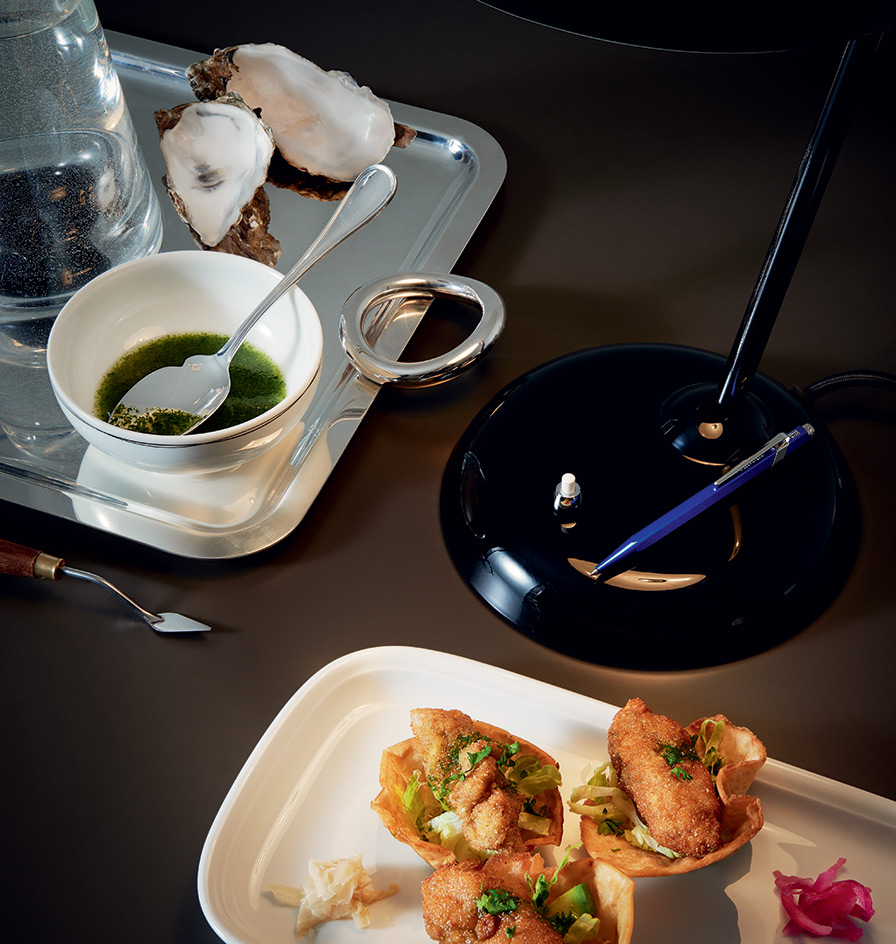
Kaki furai tacos
Simon Fujiwara’s
Born in London to a British mother and Japanese father, Simon Fujiwara has consistently used autobiographical truths to hash out issues of identity, sexuality and politics in his immersive installations. Now based between Berlin and Mexico City, the artist has chosen a recipe for deep-fried oyster tacos that brings together the best of two worlds. Like his work, this hearty dish is a heady mix of cultural references and ambiguous origins. ‘I generally don’t like fusion food, especially involving Japanese cuisine, but the purity of Japanese food is itself a myth. Over the centuries it has been influenced by foreign foods,’ explains Fujiwara, who also holds great admiration for Mexico’s diverse gastronomy. Enjoy while hot. For the recipe, click here.
Pictured: 'Modulor’ table, €1,400, by Claesson Koivisto Rune, for Skandiform, from Kinnarps. ‘Fia’ carafe, £60, by Nina Jobs, from Design House Stockholm. ‘Vertigo’ silver tray, €290; ‘Vertigo’ cup, €94, both by Andrée Putman, for Christofle. ‘Albi’ serving spoon, €179, by Christofle. ‘Kaiser Idell‘ table lamp, €419, by Christian Dell, from Fritz Hansen. ‘849 PopLine’ ballpoint pen, £22, by Caran d’Ache. ‘Trend’ sandwich tray, £48, by Thomas, for Rosenthal. Photography: Gustav Almestål. Interiors: Maria Sobrino. Food: Elisabeth Johansson. Writer: Pei-Ru Keh

Fresh summer rosenade
Dries Van Noten’s
Dries Van Noten’s green thumb is no secret. The Belgian fashion designer has famously credited gardening as his way of dealing with the stresses of the fashion industry, and he has the plot to prove it. His flower-filled, 60-acre estate, located 20 miles outside of Antwerp, is tended to all year round, whether he has a collection to create or not. Van Noten’s favoured recipe – a reviving summer lemonade made with plenty of rose petals from the garden – reaps the fruits of his labours. Sumptuous, delicate and a little offbeat (it involves no lemons), the drink is the perfect embodiment of Van Noten’s artistic, nature-driven aesthetic. For the recipe, click here.
Pictured: 'Mille Nuits Candy Box’, £1,550; ‘Harmonie’ highball, £160, both by Baccarat, from Harrods. Stirrer, £19, by Ettore Sottsass, for Alessi. ‘Fantasy’ pitcher, €120, by Vista Alegre. ‘Forenza’ fabric in Palm, £57 per m, by Romo. Coat; skirt, prices on request, both by Dries Van Noten. Photography: John Short. Interiors: Maria Sobrino. Writer: Pei-Ru Keh

Rubens sandwich
Allen Jones’
British artist Allen Jones is best known for his pop-fetishist sculptures. His fantasy evening out imagines familiar names from the art world in alluring new combinations: ‘For a Goode night out, Dine at Bower House in Scottland. As an aperitif, try our Ramos Fizz, a little beauty. Or drink Beau de l’aire from our Wells in Skye. Start with Eggs Gauguin spiced with some Vargas sauce, followed by Boeuf Waddington, either rare or with a pinch of salt. Try our Rubens sandwich with a César salad on the side. Finish with František cupcakes or a Baselitz Blitz cocktail. Have a Kapoor Weiwei tea or a Mucha coffee. Light entertainment is provided by Frank Stella, who will tell you all the tittle Tuttle. Similar arrangements are available at the Bell Inn near Jones Beach.’ For the recipe, click here.
Pictured: 'Bresson’ coffee table, £2,900, by Rodolfo Dordoni, for Minotti. ‘Ca’ d’Oro’ plate, £78, by Sieger by Fürstenberg, from Thomas Goode. ‘Touch Me’ rug, £195 per sq m, by Stepevi. Shoes, £375, by Jimmy Choo. Photography: Gustav Almestål. Interiors: Benjamin Kempton. Entertaining Director: Melina Keays

Romeo & Juliet
Vik Muniz’s
Vik Muniz’s trademark style is to make art out of non-art materials. Over the years this has included food, so we were intrigued to see what edible masterpiece the Brazilian artist would send us. He says, ‘Although the unlikely combination of cheese and goiabada (guava paste) may sound like an eccentric gastronomic experiment, Romeu e Julieta, as Brazilians call it, is one of the most popular working-class dishes in the country. As a child, I always thought that Shakespeare’s characters were, in fact, inspired by this dubious communion between briny cheese and sweet goiabada. Just remember that Juliet is the goiabada and Romeo is the cheese.’ For the recipe, click here.
Pictured: 1950s jacaranda table, £1,250, from Silvia Nayla. ‘Saturne’ vodka glass, £103, by Ercuis, from Harlequin. ‘Cosmopolitan Mesh Gold’ plate, £98, by Meissen, from Harrods. Shotgun toothpicks, £100 each, from William & Son. ‘Romeo’ fabric, £64 per m, by Nya Nordiska. Photography: Gustav Almestål. Interiors: Maria Sobrino. Food: Marie-Ange Lapierre

Oysters and truffle
Daniel Buren’s
It’s tempting to see Daniel Buren’s oysters and truffle, presented here, as a comestible manifestation of his most celebrated artistic forms. The components themselves are rare and exquisite - what the French artist describes as a ‘paradisiac surprise’ - and consist simply of a couple of oysters covered with a gill of black truffle. Accessorise as you see fit. In this case, we’ve chosen crushed ice carried in a translucent raft of coloured glass vessels, a nod to Buren’s 2012 Excentrique(s) installation at Paris’ Grand Palais. The artist filled the Beaux-Arts masterpiece with a layer of coloured lenses, filtering visitors’ views of the structure. It’s lucky that there’s an ‘r’ in the next few months and the Périgord season is fast approaching, although picking up the bill will be the biggest challenge for this sybaritic snack.
Pictured: 'Cup' bowls, €24 each, by Ichiro Iwasaki, for Discipline. Photography: Stephen Lenthall. Writer: Jonathan Bell

Chestnut fritter and brocciu
Pierre Hardy’s
Couture’s go-to design artisan, Pierre Hardy produces shoes for his own eponymous label and a neat line in graphic bags and other accessories. He has overseen jewellery at Hermès for the past decade, and created shoe designs for the brand and for Balenciaga under Nicolas Ghesquière’s tenure as creative director. But Hardy is, very much, an artist. He studied fine arts at Paris’ École Normale Supérieure and worked as a fashion illustrator before being spotted by Dior. He still teaches at a Parisian art school. Last year, Wallpaper* gave him a Design Award for his travel sprays (Best New Grooming Product, W*167). While so typically French in the breadth of his talents, Hardy traces his ancestry specifically to Corsica. And hence his choice of recipe, a traditional Corsican chestnut-flour fritter. It must be served with brocciu, or Corsican sheep’s cheese, which of course we knew. For the recipe, click here.
Pictured: Boots, £745, by Pierre Hardy. 'Colours' dessert plate, £20, by Vista Alegre. 'By' dessert knife, £79; 'By' dessert fork, £68, both by Christofle, from Harrods. 'Feature' wallpaper, £85 per sq m, by Carlucci, for JAB Anstoetz. Photography: Gustav Almestål. Interiors: Maria Sobrino. Food: Georgie Besterman
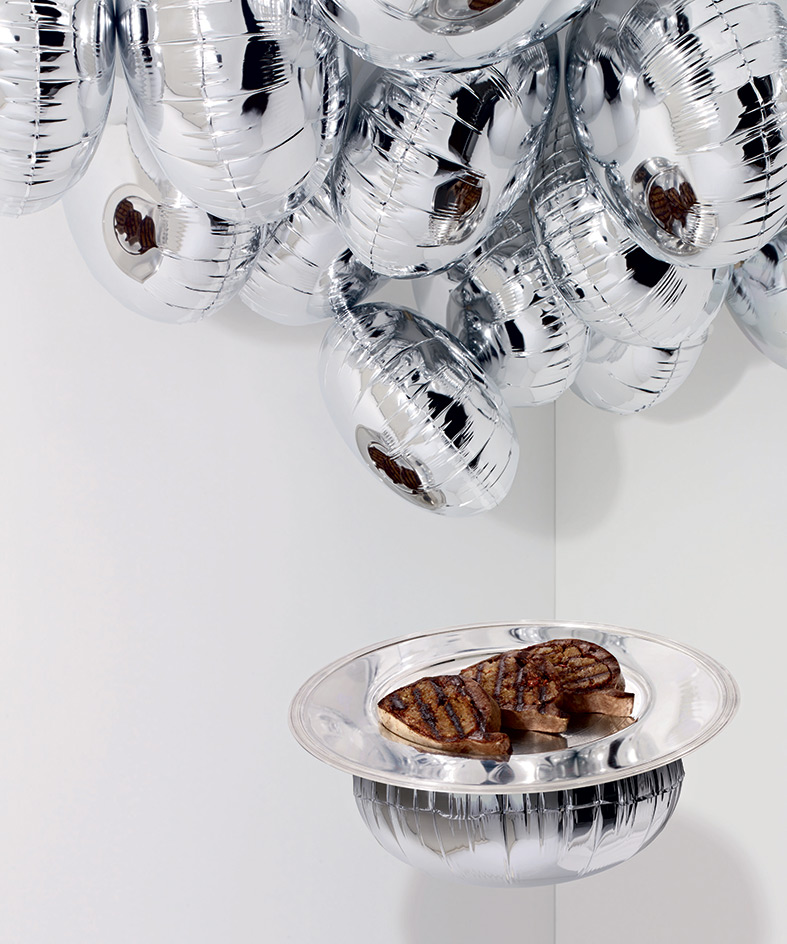
Stuffed spleen
Philippe Parreno’s
French multimedia artist Philippe Parreno (W*176) orchestrates his exhibitions (such as last year’s critical smash at the Palais de Tokyo in Paris) like an immersive performance of film, objects and sound. The dish he has sent us is a harder sell. ‘It is made from veal spleen stuffed with pork, veal fat, stale breadcrumbs, cumin, garlic, cayenne pepper, salt, pepper and parsley. Sounds disgusting but it’s fantastic,’ he maintains. ‘The recipe comes from a book, a collection of Jewish-Spanish North African recipes, that was made for me by my late mother. These are very old recipes – you wouldn’t find them in modern cookbooks, as people just don’t eat like this anymore. My mother included sayings from her grandmother on the pages facing each recipe. It’s morbid. My mother is dead, my great-grandmother is dead and the recipes are not cooked anymore. A book of death!’ Still, don’t let us put you off. For the recipe, click here.
Pictured: 'Albi’ silver-plated underplate, £388, by Christofle, from Harrods. Photography: John Short. Interiors: Maria Sobrino. Food: Maud Eden
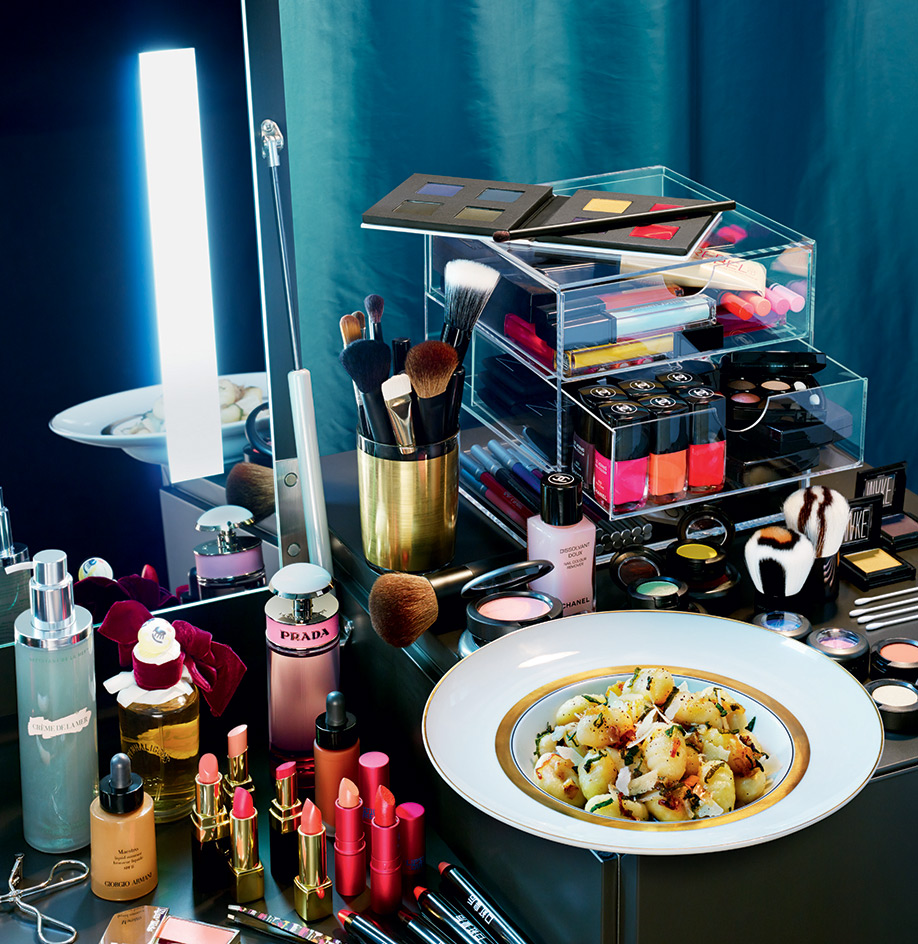
Gnocchi with sage and butter sauce
Cindy Sherman’s
Cindy Sherman is the conceptual portrait photographer with herself as sole subject, lauded by Billy Bragg in Cindy of a Thousand Lives. At once photographer, model, make-up artist, hairdresser, stylist and wardrobe mistress, she’s also a dab hand with a ball of potato and flour. ‘This step is more complicated to explain than it is to execute,’ she warns when describing how to use a floured fork to make her gnocchi crescent-shaped and ridged – the better to catch extra sauce. Her images of film-noir starlets, porn models, hitchhikers, clowns, socialites and Old Master milkmaids all require viewing rather than explaining. They can be funny and grotesque, disturbing and nostalgic – and frequently sunburned. For the recipe, click here.
Pictured: ‘Hesperide’ make-up table and stool, €5,227, by Carsten Gollnick, for Schönbuch. ‘L’Aube Veilleurs de Nuit’ tumbler, £175, by Saint-Louis, from Luxury Living. ‘Domo Gold’ plate, £35, by Vista Alegre. ‘Clear 3-drawer 20’, €74, by Nomess Copenhagen, from Harrods. ‘Diva’ fabric (background), £73 per m, by Nya Nordiska. Photography: John Short. Interiors: Maria Sobrino. Food: Nicolas Ghirlando. Writer: Paul McCann

Grandma’s roast pork with dumplings
Tobias Rehberger’s
We love Tobias Rehberger. We love the colours. We love the stripes. We love the bold graphics and hurtling shapes. We love the seasick-inducing over-stimulation of our senses and we love his new exhibition, ‘Home and Away and Outside’, at the Schirn Kunsthalle, Frankfurt. (Although you may need an aspirin to get through the first room, inspired by nautical camouflage.) Clearly, the German-born, Golden Lion-winning sculptor and installation artist loves his grandma, whose pork neck with caraway seeds and dumplings is as German as a ß. His grandma would cook for large groups of people but never eat with the rest of them – she liked to serve up and fall asleep in a corner to the sound of her family eating her food. So now we love his grandma too. For the recipe, click here.
Pictured: ’Chess’ table, £675, by Front, for Moooi, from Harrods. Espresso cups, €115 for six-piece set, by Tobias Rehberger, for Illy. ‘Sol Y Sombra’ cereal bowl and dessert plate, £42 each, by Christian Lacroix, for Vista Alegre. ’Berlin’ bowl, £116, by Meissen. ‘Extension’ coffee table, £2,760, by Alexandre Gaillard, for Roche Bobois. 'Cutt’ fork and knife, €1,500 for five-piece set, by Thomas Feichtner, for Wiener Silber Manufactur. Photography: Beate Sonnenberg. Interiors: Maria Sobrino. Writer: Paul McCann

Fondue moitié-moitié
Christian Marclay’s
Swiss-American artist Christian Marclay is the coolest person to advocate a silky smooth combination of Gruyère and Vacherin Fribourgeois in quite some time. Marclay, who has won the Golden Lion at the Venice Biennale, had solo shows from LA to Seoul, and guest-edited W*151, is a sort of sound surrealist. He juxtaposes appropriated movie clips, images of instruments and musicians to make audio-visual collages. Having once made art from an accordion, with 7m bellows, making fondue hip again should be a cinch. Don’t forget to rub your caquelon with garlic. For the recipe, click here.
Pictured: 'Matégot Kangourou’ table, £269, by Mathieu Matégot, for Gubi. ‘Initiales Parallèles’ dessert plate, £64, by Puiforcat, from Harrods. Pinch pot, £16, by Ian McIntyre, for Another Country. Mont d’Or cheese, £16 per 500g; Gruyère, £27.50 per kg, both from Jeroboams. Fondue set, £90, by Emile Henry, from Divertimenti. ‘Series 4’ French horn, £2,820, by Paxman. ‘Shuffle’ playing cards, by Christian Marclay. Fendant Balavaud Grand Cru, Jean-René Germanier, £23, from Alpine Wines. ‘Château Baccarat’ wine glass, €75, by Baccarat. ‘Oak Silver Grey’ flooring, £28.50 per sq m, by Parador. Photography: Gustav Almestål. Interiors: Maria Sobrino. Writer: Paul McCann

Whipped fog jubilee
Rick Owens’
There’s a lot more substance to the work of Rick Owens than there is to his favourite dish. In fact, the fashion designer admits it's not fattening at all, ‘because it's mostly air’. The art school dropout has gone from pattern-making courses at LA Trade-Technical College to the catwalks of Paris by giving rock stars (and those who want to look like them) something to wear to gallery openings - usually something asymmetrical in leather, wool and dark grey. A kind of couture goth, with the physique of a Californian gym bunny, Owens has a slouchy style that belies his impeccable tailoring and technical skills. His favourite dish has an altogether more elusive quality. He instructs us to ‘have a neighbour’ make us some fresh whipped cream with egg whites and then serve it in an art nouveau bowl by George Hoentschel, floating on dry ice and sprinkled with sugar. In a first for this series, he also specifies the spoon you should eat with – a Josef Hoffman ‘round model’ - and a musical accompaniment – Monserrat Caballé.
Pictured: Bowl, price on request, by George Hoentschel, from Jason Jacques Gallery. ‘Rundes Modell’ tablespoon, £106 for set of six, by Josef Hoffmann, for Alessi. ‘Dark Coffeecube in Scrapwood’ table, $4,251, by Piet Hein Eek, from The Future Perfect. Photography: Zachary Zavislak. Interiors: Maria Sobrino. Writer: Paul McCann

‘Oatmeal for one’
Joseph Kosuth’s

‘She who possesses 100 husbands’
Linder’s
Since bursting onto the art scene in the late 1970s, the feminist British artist Linder (full name Linder Sterling) has pulled no punches when it comes to portraying a woman’s sexual prowess. Her reviving Ayurvedic elixir is just as potent. The main ingredient is shatavari – otherwise known as ‘she who possesses 100 husbands’ – a herbal aphrodisiac said to impart the reproductive strength to cater to as many partners. Sterling brews the root, or its powdered form (right), with a gold ring, believed to improve stamina and strengthen the heart, and organic rose petals. Finished with organic honey, the arousing tonic can be enjoyed hot or cold, and is best served with a partner, of course. For the recipe, click here.
Pictured: Artwork, by Linder. Gold ‘Infinity’ band, £525, by De Beers. ‘Perfection’ tumbler, £62, by Baccarat, from Thomas Goode. ‘Mono-a’ gold-plated spoon, €385 for a five-piece set, by Mono. ‘Solid Colors 409 Latte’ laminate, from £30 a sheet, by Abet Laminati. Photograpy: John Short. Interiors: Matthew Morris. Food: Maud Eden. Writer: Pei-Ru Keh
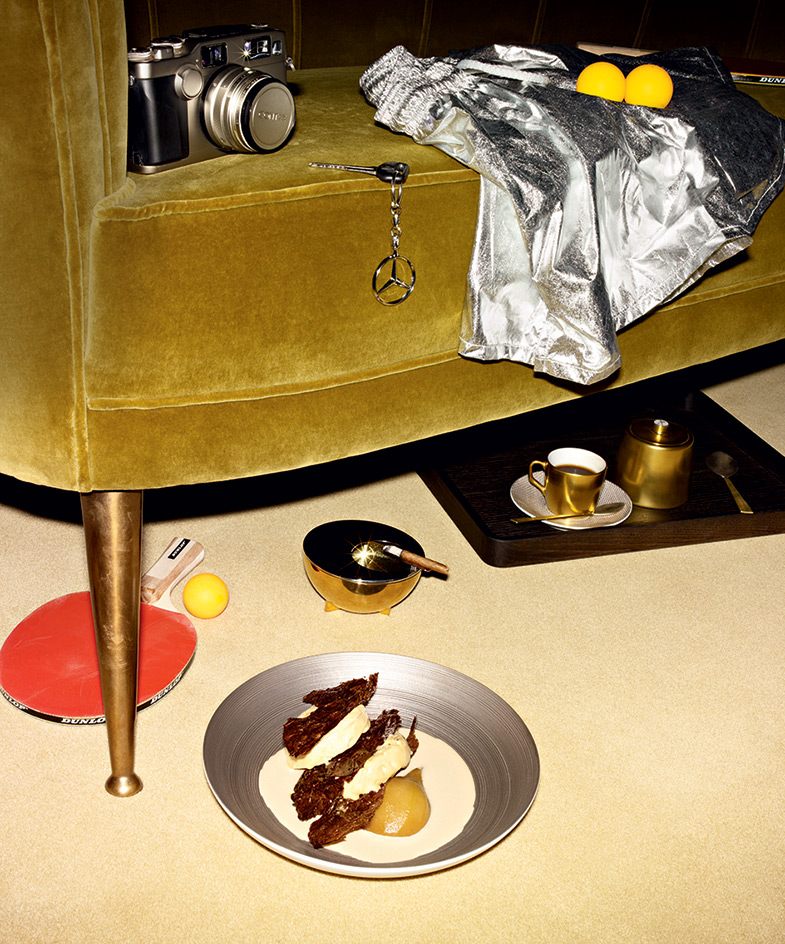
Tobacco ice cream
Juergen Teller’s
The great thing about Juergen Teller’s photography is the intimacy he captures, even with the celebrities that, by rights, should be so distant from us. Whether it’s Victoria Beckham in a bag or Kate Moss in a wheelbarrow, Teller’s images tease us with the sense that they are our famous friends, too; larking about for our lens. But much of this is artifice. They are not his friends and nor is his favourite dish something he is likely to whip up chez Teller. Given the 26 egg yolks, liquorice extract and tobacco leaves, it seems much more likely that he has it made for him by chef Antonio Guida in the two Michelin-starred kitchen of Tuscan bolt-hole Il Pellicano, whose recipes just happen to be the subject of Teller’s latest book. For the recipe, click here.
Pictured: Table tennis set, £8, from Dunlop. ‘Maya’ sofa, £2,710, by Brabbu, from EDC London. ‘Contax G2’ camera, secondhand. ‘Hemisphere’ metallic pasta bowl, £62, by JL Coquet, from Willer. ‘90047’ ashtray, £110, by Marianne Brandt, for Alessi. Keyring, £6.50, by Mercedes- Benz. Shorts, £30, by American Apparel. Tea tray, £53, by Pierre Casenove, for Pic Vert et Cie, from SCP. ‘Cosmopolitan’ espresso cup, £160; saucer, £230; sugar bowl, £179, all by Meissen, from Harrods. ‘Ihada’ teaspoon, £55; large spoon, £60, both by Oji Masanori, for Futagami, from The Cold Press. ‘Majestic Marrakesh M56’ carpet, £100 per sq m, from Brintons. Photography: John Short. Entertaining Director: Melina Keays. Interiors: Maria Sobrino. Writer: Paul McCann

Roast boned rolled stuffed shoulder of lamb
Carsten Höller’s
Carsten Höller, the Belgian artist who put slides in Tate Modern’s turbine hall, professes not to have a favourite dish per se. Which might have put a bit of an existential downer on this month’s artist’s recipe page. Luckily, ol’ Carsten is made of more complex stuff than those whose favourite food is for eating. He has a favourite recipe that is a non-recipe. How we laughed. His dish is one that sort of appears in Harry Mathews’ short story, Country Cooking from Central France: Roast Boned Rolled Stuffed Shoulder of Lamb (Farce Double). This begins as a recipe (marinate the lamb for five or six days in 2 quarts of white wine, 2 quarts of olive oil and the juice of 16 lemons) before becoming a shaggy-dog story about a blacksmith’s son and a shepherdess. It’s worth knowing that Mathews liked to hang out with Georges Perec, the laugh-a-minute writer who composed a novel without using the letter ‘e’. Good luck finding the mouthless freshwater fish for the stuffing. For the recipe, click here.
Photography: Zachary Zavislak. Interiors: Maria Sobrino. Writer: Paul McCann

Roger Hiorn’s
Insalata Caprese
Roger Hiorns’ art, relying as it sometimes does on naturally occurring chemical reactions and the crystallising process of copper sulphate, is not dissimilar to his recipe. Hiorns lets the material do what it needs to do. It creeps and grows and makes its own aesthetic decisions, no more so than when he created a fantastic blue crystal landscape in a London flat. The installation, Seizure, was a smash. Beyond the small matter of inserting two containers’ worth of copper sulphate into the flat, Seizure did much of the heavy lifting itself. As does insalata Caprese. This colourful mozzarella, basil and tomato salad lets the ingredients do the work. For the recipe, click here.
Photography: John Short. Interiors: Maria Sobrino. Writer: Paul McCann

Valentino’s
Salad of artichokes & spinach
This month’s recipe is from the famous Italian fashion designer, but was written in French. This is not just a sign of the years Valentino spent at the École de la Chambre Syndicale de la Couture Parisienne, then serving his apprenticeship in the city, or his decades as a rival to the great Paris couture houses. It is also about his love of entertaining at Château de Wideville. Valentino bought the estate, 30km west of Paris, in 1995. It has been known to host parties that would make Elton John blush at the excess. Yet Valentino has suggested a dish that is practically an exercise in restraint – at least for a man who often has an extra limousine just for his pugs. It is an elegant, French country salad of artichokes, spinach shoots, curly endive, tomatoes and poached eggs. The hollandaise, made with ten egg yolks, is rich, but not nearly as rich as the man himself. For the recipe, click here.
Photography: John Short. Interiors: Maria Sobrino. Food: Maud Eden. Writer: Paul McCann

Mum’s pancakes
Ian Davenport’s
If only all the artists who contribute to this feature were as helpfully literal as Ian Davenport. Some of the time we have to, ahem, build a metaphorical link between the recipe and an artist’s practice that is as flimsy as a rope bridge in an action movie. But not so this month. Davenport, who created the cover of our September 2006 issue (W*91) as part of a series celebrating our 10th anniversary, included with his pancake recipe 24 photographs of him creating a painting inspired by the act of flipping a pancake. It showed a circular painting being rotated through 180° so that its wet paint splattered onto the floor below. Davenport, who is interested in the organic nature of paint and the way it drips and pours, using paint-filled syringes and gravity, learned to drip and pour batter from his mother. He obviously learned well. He participated in the seminal 1988 Freeze exhibition and in 1991 was nominated for the Turner Prize at just 25. His largest work, Poured Lines: Southwark, is a 50m-long painting on steel under a railway bridge, not far from W* HQ, that fairly cheers the soul. For the recipe, click here.
Photography: Zachary Zavislak. Interiors: Pei-Ru Keh. Writer: Paul McCann
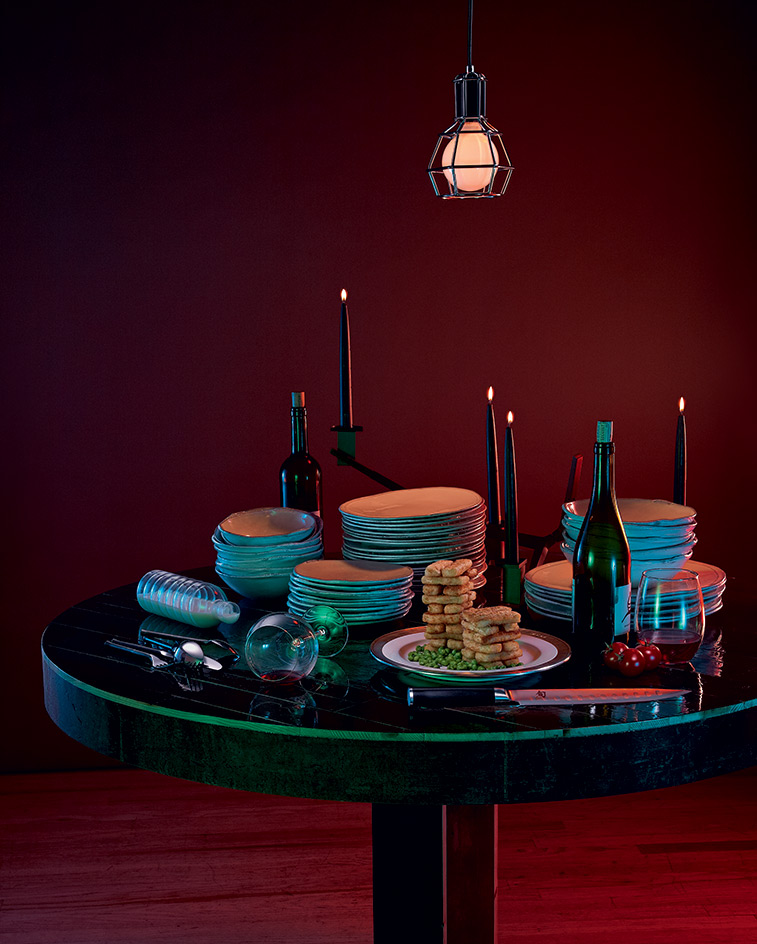
Fish finger pie
Mike Nelson’s
Mike Nelson, whose immersive, labyrinthine installations have seen him twice nominated for the Turner Prize, and who, in 2011, represented Britain at the Venice Biennale, arranged to do some dog-sitting in a cramped South London flat in the summer of 1990. On his first day in residence he went out and bought a big bag of frozen fish fingers and frozen peas. On his return to the flat he discovered its refrigerator had no freezer compartment. And so was born the fish finger pie – basically a fish pie with added orange breadcrumbs. ‘This dish was the result of necessity but proved strangely palatable. I remember clearly how to make it – almost like a savoury trifle, layering the fish fingers in a white sauce, with the peas to add more colour and structure to this colossus of dishes, and with it finally topped with mashed potato.’ A dish both crazy and comforting. For the recipe, click here.
Photography: Zachary Zavislak. Interiors: Pei-Ru Keh. Writer: Paul McCann

Lulas guisadas
Paula Rego’s
For all the fame of bacalhau, it’s often squid stewed in tomatoes that is the real childhood comfort food of the ex-patriot Portuguese and their co-linguists from Mozambique to Brazil. Paula Rego’s grandchildren are no exception and have grown up having her simple version of the stew for Sunday lunch. She cooks hers in onions, tomatoes and parsley for an hour or so, until the squid is melting into the sauce. As a dish it has a rootedness which echoes the Portuguese fables told in her paintings. And the squid, as a creature, is as much a beautiful grotesque as any of the spiders, skeletons or squatting women who populate her tableaux. It certainly makes a more Rego-esque Sunday lunch than roast beef and Yorkshire pud. Her themes of feminist folk tales and subverted myth are painted in outlines as bold as the flavours of her favourite stew. For the recipe, click here.
Photography: Zachary Zavislak. Interiors: Pei-Ru Keh. Writer: Paul McCann

Salt-baked sea bass
David Batchelor’s
Scottish-born artist, writer and Royal College of Art tutor David Batchelor uses colour to attack form, to break it down and dissolve it. He is best known for doing this with street-found objects that he hollows out, stacks and fills with coloured light to create installations, using the forms to interrogate the meaning of colour. The recipe he shares with us this month is by contrast monochrome and actually quite flat. He discovered salt-baked fish in Sardinia several years ago and has been trying to impress friends with it ever since. The secret is to use an awful lot of coarse sea salt, keeping it out of the fish’s cavity and trying to keep your guests sober before they eat it, as separating the crust from the fish can be tricky. For the recipe, click here.
Photography: Zachary Zavislak. Interiors: Pei-Ru Keh. Writer: Paul McCann
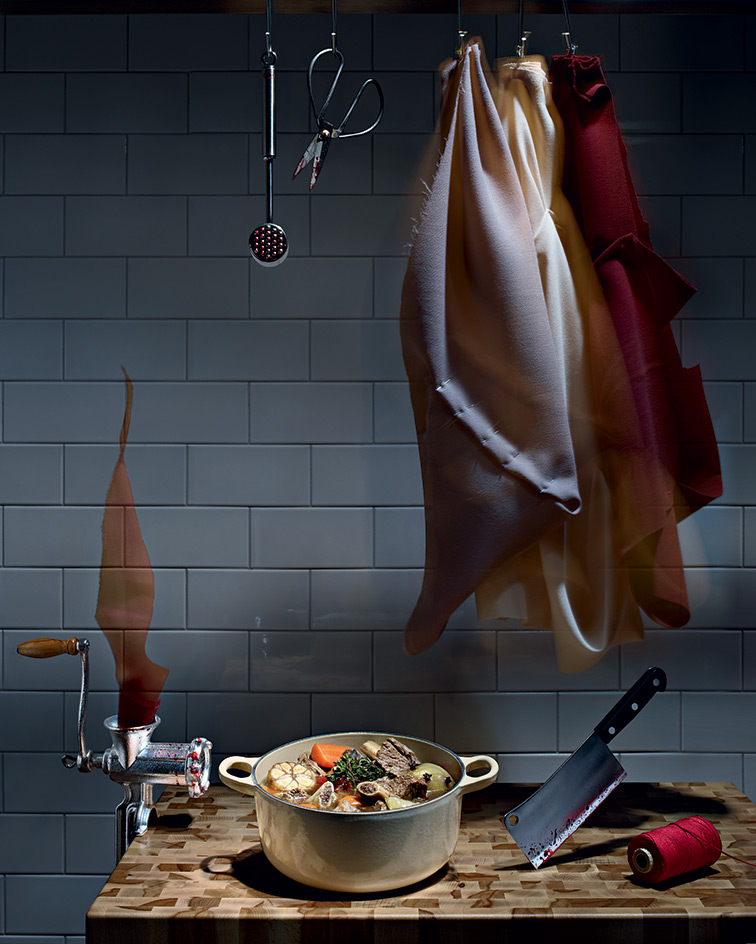
Pot-au-feu d’Élise
Roland Mouret’s
Roland Mouret’s earliest thoughts about fabric date back to the times he worked in his father’s butcher shop in Lourdes. It was there he watched how the creamy cotton of the aprons could be folded to hide bloodstains. He is also said to have learned his cutting skills from the way the skin of an animal was sliced and structure from the method of dividing a beast into sections. It may be pushing the metaphor, but there's no doubt the structure of his iconic dresses, not least the ‘Galaxy’, have flattered the carcasses of many A-list celebrities in the last decade or so. What he also took from his Lourdes childhood is a butcher's knowledge of meat. His mother Élise’s version of France’s hotpot is robust to say the least, containing oxtail, top rump, beef ribs and a veal shank cooked in five litres of water for four hours with aromatic vegetables. The regular Saturday family meal, it is a dish to put hairs on your chest. For the recipe, click here.
Photography: John Short. Interiors: Sarah McNabb. Food Stylist: Maud Eden

Marmite on toast
Jeremy Deller’s
The conceptual artist Jeremy Deller’s minimalist recipe – all the instructions you may need are in the title – conforms to his long-standing interest in very British, but often polarising folk traditions and mythologies. The Turner Prize winner orchestrated a recreation of the 1984 Battle of Orgreave – using 800 battlefield recreationists and former miners and policemen. Orgreave was a the emblematic event in one of the most politically divisive periods in recent British history. He also made a film about obsessive Depeche Mode fans, and there are many who’d argue the Basildon synth-pop pioneers are as much of an acquired taste as a salty spread extracted from yeast.
Pictured: Clockwise from left, stool, £323, by Karimoku New Standard. ‘Doney’ television, €1,350, by Brionvega. White birch frame, £20, by Habitat. Beech frame, £13, by Muji. 3D View Master, £8, by 3D Images. Union Jack flag, £54, by JW Plant. ‘Day Bed One’, £1,790, by Another Country. ‘Polo Player’ single duvet cover, £99; pillow case, £65 for pair; sheet, £49, all by Ralph Lauren Home. ‘Sarjaton' plate, £18, by Harri Koskinen, fo Iittala. ‘Santiago’ knife, £5, by David Chipperfield, for Alessi. ‘The Liverpool of Brian Epstein’, by Jeremy Deller and Paul Ryan, designed by APFEL, for Tate Liverpool. ‘Karsansui Taupe' rug, £12,235, by Michael Reeves, for The Rug Company. Matt emulsion in Chiffon White, £25 for 2.4 litres, by Dulux. Photography: Leon Chew. Interiors: Sarah McNabb. Writer: Paul McCann

Omelette
Michael Craig-Martin’s
In Michael Craig-Martin’s hands an omelette could, conceptually, be anything. If the primacy of the artist’s intention can make a glass of water An Oak Tree, as he maintained amid no little controversy in 1974, then an omelette can be anything he wants it to be. Or, indeed, anything the generations of YBAs he taught at Goldsmiths want it to be (although in their case it would often be an omelette for Charles Saatchi). It’s also the kind of everyday object that could one of his boldly outlined still-life pictures painted in ultra-vivid colours. In this case, more prosaically, what it actually is, is lunch. Additionally, it is also just about the only thing he knows how to cook. For the recipe and stockists, click here.
Photography: Zachary Zavislak. Writer: Paul McCann

Oatmeal
Pavel Pepperstein’s
For all their intellectual heft, Pavel Pepperstein’s drawings and watercolours are curiously naive and romantic. His annotations draw on cultural theory and linguistics and their take on Russia and the world, yet his constructivism, and that of his art group Inspection Medical Hermeneutics, is often delivered in the sweet language of children’s books. It is the artworks that are exhibited internationally, but at home his films, rap poetry and novels have also made him famous. For the recipe, click here.
Pictured: Clockwise from top left, ‘Brussels’ napkin, $9, by Bodrum, from Gracious Home. ‘Zermatt’ knife, $90, by Patrick Jouin, for Puiforcat. Condensed milk, $2.50, from Taste of Russia. Big Red chewing gum, $2, by Wrigley. ‘Rundes Modell’ tablespoon, £222, by Josef Hoffmann, for Alessi. ‘Mormor’ bowl, £48, by Gry Fager, from Normann Copenhagen. ‘Glacier’ table, $15,200, by Paul Loebach, for Mattermade, from Matter. ‘Kyber’ rug, $7,500, from ABC Home. Photography: Zachary Zavislak. Food: Matt Vohr. Interiors: Sarah McNabb. Writer: Paul McCann

Pedro Cabrita Reis’
Clams Bulhão Pato
Portugal’s leading conceptual artist sees his work as ‘the permanent quest for perfection’, a bridge between the studio and the everyday. His installations, sculptures and paintings are an exploraton of architectural and anthropological space. His suggested recipe, Clams Bulhão Pato, is a different kind of everyday perfection. Name after 19th-century Portugese poet Raimundo António de Bulhão Pato (no better known for the recipe than his poetry), the dish is as simple as Cabrita Reis’ work is complex: cook littleneck clams in white wine and chopped garlic, dress with coriander and serve.
Pictured: ‘Scrapwood’ wallpaper in PHE-03, $299 per roll (47 sq ft), by Piet Hein Eek, for NLXL. ‘Agnes’ 10-bulb chandelier, $8,000, by Lindsey Adelman. ‘Avva’ carafe, $85; ‘Avva’ tumbler, $46 for two, both by Thea Mehl and Rogaska Glassworks; napkin $16, by Anna Hellman and Linas. ‘Santiago’ fork and tablespoon, both part of five-piece set, $47, by David Chipperfield, for Alessi. ‘Heath Coupe’, pasta bowl, $37; cereal bowl, $28, both by Heath Ceramics. ‘Organizer’ tray, DK199 ($33) for two, by Hay. ‘Shiba’ casserole, $154, by Naoto Fukasawa, for Alessi. Photography: Zachary Zavislak. Stylist: Pei-Ru Keh. Food stylist: Matt Vohr. Writer: Paul McCann

Cornelia Parker’s
Eggs
The conceptual artist Cornelia Parker is best known for blowing up a shed. Cold Dark Matter: An Exploded View suspends the splintered result from multiple wires in a startling recreation of a split-second after the explosion. A bright light hanging in the centre creates further impact, casting exploding shadows across the gallery walls. The Maybe also attracted a lot of attention from the British press, placing a sleeping Tilda Swinton in a glass box at the Serpentine Gallery. For this recipe her instructions are suitably conceptual. She simply dictates that we cook an egg in the style of our own choosing – but do so left-handed and serve it up blindfolded. Very sinestre. And potentially messy.
Pictured: Centre, ‘Liquid‘ bowl, $150, by Georg Jensen. Clockwise from top left, ‘Twist’ plate, $75, by Georg Jensen. Egg cup, $112, by Marianne Brandt, for Alessi. ‘K+T’ salt and pepper shakers, $370, by Adam Tihany and Thomas Keller, for Christofle. ‘Santiago’ teaspoon and fork, $47 for five-piece set, by David Chipperfield, for Alessi. Egg poacher cup, $6, from Williams-Sonoma. ‘Santiago’ knife and tablespoon, $47 for five-piece set, by David Chipperfield; ‘Rundes Modell’ tablespoon and fork, $37 each, by Josef Hoffmann, both for Alessi. ‘720’ egg cup, $21, by Alessi. ‘Vertigo’ bottle coaster, $290, by Christofle. ‘Rundes Modell’ teaspoon, $96, by Josef Hoffmann; egg cup, $96, by Carlo Mazzeri and Anselmo Vitale, both for Alessi. Photography: Zachary Zavislak. Interiors: Linda Keil. Stylist: Pei-Ru Keh. Writer: Paul McCann

Spaghetti bottarga
Vidal Sassoon’s
We received this recipe from Ronnie Sassoon several months before her husband died at their Richard Neutra-designed house on Mulholland Drive in May. We present it now as our tribute to the man who revolutionised hairdressing with his geometric, easy-maintenance cutting and styling. It is a fittingly simple dish with a piquant dash of luxury. At its plainest, it is a dried chilli and garlic-infused spaghetti, but topped with parsley and the Mediterranean’s cured fish roe, bottarga. The pressed, salted and dried roe of the grey mullet, which imparts a sweet but densely briny flavour, was a delicacy Ronnie and Vidal discovered on their first trip to Sardinia and remained Vidal’s favourite dish, a dish that brings happy memories of the Med to a simple meal. We’d like to say thank you, Mr Sassoon, for all you did. For the recipe, click here.
Pictured: ‘Coupe Monochrome Ubend’ plates, $24 each, from The Conran Shop. Scissors and combs, from a selection, from Shear World. ‘Metro’ tiles, $3 per sq ft, by Nemo. Photography: Zachary Zavislak. Interiors: Linda Kell. Writer: Paul McCann

Douglas Gordon’s
Cullen skink
Turner Prize-winning multi-media artist Douglas Gordon references the mirror, memory and autobiography in much of his work. He also used the Goya portraits in Madrid’s Prado as his storyboard when preparing his real-time portrait of Zinedine Zidane, but that’s another, rather marvellous, story. This recipe is inspired by his father eating Scotland’s famous smoked haddock soup in the Glasgow institution that is Café Gandolfi. He stipulates that the fish is to come from Aberdeen; the potatoes from Ayrshire; and the sharp knife used to barely stir them should be handed down from your granny. Try to get hold of some Finnan haddie, the lightly cold-smoked haddock that goes best with the onions, leek, garlic and milk to make this dish far superior to a bisque. He also wants us to add that Café Gandolfi and his father are both still going strong. For the recipe – a piece of poetry dedicated to ‘the devil’s breakfast’ – click here.
Pictured: ‘Navy Fringe’ bowl, price on request, by Jasper Conran, for Wedgwood. ‘Bettina’ tablespoon, £9.50, by Future Systems, for Alessi. ‘Wexford’ plaid fabric, £120 per sq m; ‘Ayers’ place-card holders, £175 for set of four, both by Ralph Lauren Home. Mirrored glass, £46 per sq m, by Ward Glass. Photography: Beate Sonnenberg. Food stylist: Nico Ghirlando. Writer: Paul McCann

Richard Woods’
Choc mock-Tudor biscuits
Often with our back page recipe, we have to stretch the ol’ recipe-as-metaphor-for-the-artist’s-work to breaking point (and sometimes well past it, too). But not so this month; artist Richard Woods has produced a dish actually modelled on his own work. Well known for his faux house renovations and his signature multicoloured woodgrain patterns, he has served up a biscuit recipe with its own mock-Tudor panelling. Woods, who created a limited edition cover for W*117 in 2008, is a fan of surface manipulations and home décor makeover shows. He transformed a SoHo gallery into a black and white mock-Tudor installation, and then did the same for art collector Adam Lindemann’s house in Woodstock, New York. So his shock-mock-Tudor style is found in unlikely places, which is sort of the point. Now you can dip a Woods-inspired piece of art in your tea. Not something you can say about many artworks. For the recipe, click here.
Pictured: ‘Hay Bale’, £410 each, by Richard Woods and Sebastian Wrong, for Established & Sons. Large plates, £13 each, by Höganäs Keramik, from The Lollipop Shoppe. ‘Bazelaire’ small plate, £17, by Brigitte de Bazelaire, from SCP. Willow plywood tray, £30, by Corin Mellor, for David Mellor. Napkins, £25 each, by Willer. ‘Yaki’ teapot, £49, by Anouk Jansen, Jansen + Co from Toast. ‘My Mug’, £8; ‘My Milk Jug’, £15, both by Anouk Jansen, for Jansen + Co, from SCP. Photography: Stephen Lenthall. Writer: Paul McCann

Franz West’s
Pork belly pancake
The plethora of Germanic dishes that include a part of the pig served with sauerkraut is expressive of a deep national affinity. Whether it be pork snouts from Schleswig-Holstein; the all-in Schlachtplatte; some tasty sow’s stomach by the name of Saumagen; or Bavaria’s Schlachtschüssel and Schweinshaxe, they are usually a sibilant mouthful in more ways than one. This dish served up by impish Austrian sculptor Franz West is
called – by him at least – Bohemian-Moravian fly and is actually quite tame, involving as it does just pork belly, sauerkraut, plum sauce and boiled egg on a pancake. No stuffed innards, no fried extremities and no spraying the waiter with saliva when you order it. In awarding him a Golden Lion for career achievement, the Venice Biennale last year called him ‘one of the most important
artists in the world working in sculpture, collage and installation’. The Los Angeles Times went with ‘Benny Hill with brains’. We find his work touching and touchable. For the recipe, click here.
Pictured: Stand, courtesy of David Buckley. Photography: John Short. Food stylist: Maud Eden. Writer: Paul McCann

Pasta ai Caviale
Donatella Versace’s
Muse, critic, designer, entrepreneur, company saviour and first lady of fashion, Donatella Versace may have tempered the sex and theatricality of the family brand a little, but there's still glamour galore in her output and appearance. Her favourite dish of pasta and caviar is mostly associated with romantic couples dining alfresco on the Ligurian Riviera, rather than with her native Calabria, although that's probably down to fewer visitors making it to the toe of the boot. It is a simple, high-quality and unfussy dish – made mainly with spring onions, parsley and cream – topped off with a dollop of the rarefied and distinctly flash. Now where can she have got that idea from? For the recipe, click here.
Pictured: Italian 1980s occasional table, £2,950, from Talisman. ‘Vanity’ plate, £70; ‘Vanity’ deep plate, £65; gold-plate fork, £229; knife, £249; ‘Gorgona’ vase (left), £389, all by Versace; tumbler, £75, by Moser; 'Brainstone' vase (right), £3,500, by Wedgwood, all from Harrods. Salt pot, $74, by Devi Design. Vide poche, £130, by Asprey. ‘Emotion-Jaune 1628-03’ curtain fabric, £185 per m, by Tassinari & Chatel, for Lelievre. ‘Blue Ground no. 210’ estate emulstion, £32.50 for 2.5 litres, by Farrow & Ball. Photography: John Short. Food stylist: Maud Eden. Writer: Paul McCann
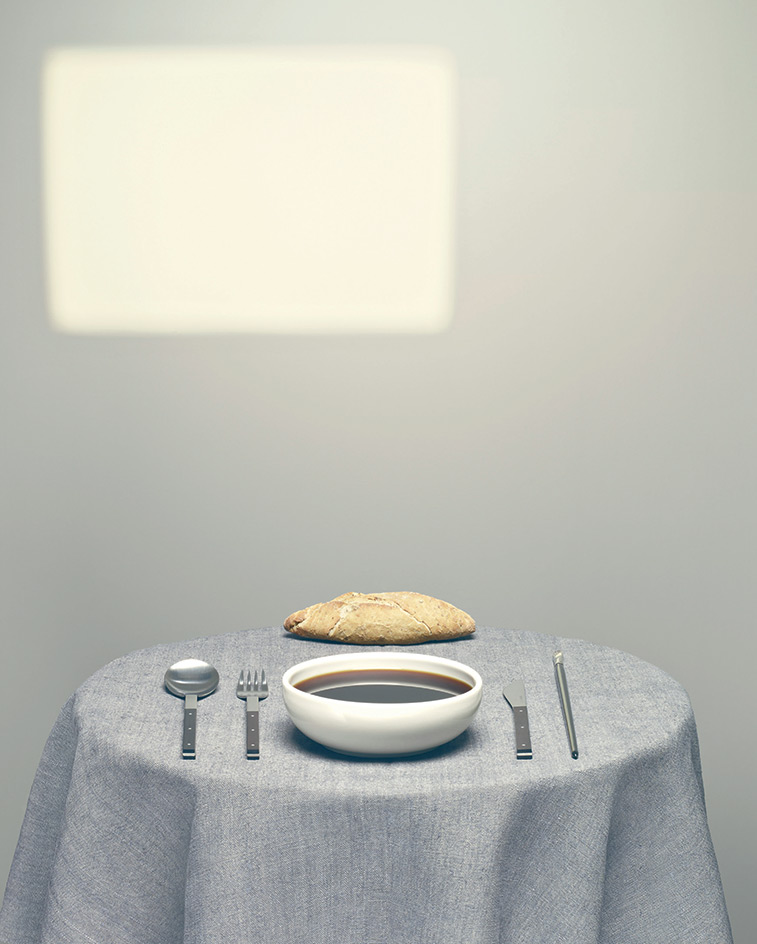
Oxtail consommé
Luc Tuymans’
It is argued that Belgium’s Luc Tuymans kept figurative painting alive as a contemporary art form during the 1980s and 1990s by acknowledging its limitations. His medium is one that can only be partial and subjective, so he works at the level of vague hints and subtle allusions, with his topics – often expressed with a quiet, vague horror – heavily cropped, framed and dealt with in filmic close-up. Tackling thorny subjects from the Holocaust to 9/11, the Belgian Congo to the unsettlingly banal still life, his palette of muted whites and murky pastels arouse complex, difficult to express emotions. Complexity there is, too, in his consommé, requiring as it does five hours' simmering, overnight chilling and a difficult to get right clarification process involving egg whites and minced beef. Nose-to-tail eating has brought the oxtail back into fashion; Tuymans’ chilly, ambiguous works did the same for the artist as painter. For the recipe, click here.
Pictured: Porcelain bowl, £16.50, by Ian McIntyre, for Another Country. ‘Mono-e’ spoon, €45; fork, €45; knife, €56, all by Peter Raacke, for Mono. ‘Black Russian’ sable oil brush, £6.10, from Green & Stone of Chelsea. Nineteenth century French linen table cloth (vegetable-dyed pale grey), £360, from Guinevere. ‘Charleston Gray’ estate emulsion, £30 per 2.5 litres, by Farrow & Ball. Photography: John Short. Food stylist: Laura Fyfe. Writer: Paul McCann

Spaghetti arrabiatta
Idris Khan’s
Idris Khan plumps for spaghetti arrabbiata because his wife loves spaghetti and he really, really loves chillies. As far as we are concerned he can have what he likes. He is an artist brave enough to successfully embrace, appropriate and recontextualise major artworks from the historical canon – by Caravaggio, JMW Turner and Leonardo da Vinci, to name just a few of the bigger hitters. His digitally layered photographs have also embraced texts, including the Koran, and musical scores. Turning to the giants of 20th century photography, he also even applied his impressionistic approach to the wholly representational record photography of Bernd and Hilla Becher. Brave, talented and original; we’ll even make it for him ourselves. For the recipe, click here.
Photography: Richard Foster. Writer: Paul McCann

Chicken casserole
Dexter Dalwood’s
Painter Dexter Dalwood explores the domestic details of historic figures. His works include imaginings of the insides of OJ Simpson’s white Bronco, Mao’s study and Kurt Cobain’s ‘greenhouse’. His pieces also reference artists such as Henri Matisse, Francis Bacon and Ed Ruscha, so the fact that his recipe comes from Jean Renoir’s memoir is no surprise. Renoir's mother, Aline Charigot, made this chicken stew for her boy, the famous film-maker, and his father, the famous impressionist.
The excerpt below is taken from Jean Renoir’s biography, Renoir, My Father (New York Review Books Classics), in which he recalls that his mother considered the dish ‘one of her greatest triumphs’.
‘To prepare it she cut the chicken up in pieces, which she browned in a heavy casserole with a little olive oil. As soon as the pieces were ready, she put them aside on a warm plate. The oil was then thrown away, and the chicken put back in the casserole with just a dab of butter. Next she added finely chopped onions, two peeled medium-size tomatoes, some sprigs of parsley and thyme, a bay leaf, a clove of garlic, salt and pepper, and a very little hot water. The mixture was stirred from time to time to avoid burning and allowed to simmer over a slow fire. A few mushrooms were thrown in half an hour before serving; Greek, Italian, or Provençal black olives; and the chicken-liver. At the last moment a little glass of brandy was added, and the lid of the casserole left off to let the fumes evaporate. When serving, she sprinkled chopped parsley and garlic over the dish.’
Photography: Zachary Zavisklak. Interiors: Linda Keil. Writer: Paul McCann

Croquettes de crabe
Alber Elbaz’s
Alber Elbaz, Lanvin’s creative director, saviour and fashion superstar, once told The New York Times: ‘I can never make a cake because they tell you ten grammes of this, and ten minutes here. I can’t follow those kinds of rules. And I do not crave that kind of perfection. And neither do the women I dress.’ So when he suggested crab croquettes in the shape of an oversized bow tie, we finessed the recipe for him. The chair wearing the crab bow tie here is by Albert-Armand Rateau, who collaborated with Jeanne Lanvin on her boutique and apartment interiors and ran Lanvin’s interiors department in the 1920s. For the recipe, click here.
Pictured: Nebb glasses, from $225, by Moscot. Plate, $50; napkin, $15, both from ABC Home. Photography: Zachary Zavislak. Writer: Paul McCann

Richard Tuttle’s
Healthy cookie
Richard Tuttle’s intimate, minimalist paintings, drawings and sculptures express a parsimonious nature. The rangy American is as sparse with his materials and artistic gestures as the landscape around his New Mexico studio. But while he has an economy of style, his works contain whole heaps of meaning. This is an artist who flirts with nothingness and has inspired many contemporary artists to do likewise. Cookies baked with stevia powder and spelt before being topped with goat's butter have their own meaning. Stevia is a natural sweetener found in a South American herb. The FDA once banned it. Wholefood aficionados consider the stevia ban a scandalous sop to the food industry by the US government. Spelt is fashionable-again Bronze Age wheat with claims to nutritional benefits absent in modern wheat strains. Goat’s butter is for those avoiding cow’s milk. These are good cookies for good people. For the recipe, click here.
Pictured: Dinner plate, £28, part of the Brushstroke Collection, by Diane von Furstenberg, from Bloomingdales. Photography: Zachary Zavisklak. Interiors: Linda Keil. Writer: Paul McCann

Ryan Gander’s
Mizutaki
Ryan Gander’s practice involves a lot of playful puzzles, cultural collisions and meta-versions of reality. Through his sculpture, installations, photography, books and lectures, he combines disparate cultural objects into stories without the assemblage ever coming to a closed and final resolution. Mizutaki, in contrast, is an assemblage of Western consommé and Chinese chicken soup that resolves itself quite straightforwardly into a warming broth that sits bubbling on your table. For the recipe, click here.
Pictured: ‘Parallel Cards’, an art project by Gander with Europa and Rasmus Troelsen. ‘Rainbow’ chopsticks, $32, by Takashi Kamijo, from MoMA Store. Chopsticks rest, $4, by Muji. Bowl, price on request, by Mud Australia, from ABC Home. Photography: Zachary Zavislak. Interiors: Jeanne Lurvey. Writer: Paul McCann

Pecan pie
Tom Ford’s
Apple pie may have become an American icon, but sticky-sweet pecan pie is the one everyone takes to family gatherings, especially Thanksgiving and Christmas. Some say it has its roots in New Orleans and the meeting of French settlers with Native Americans. More patriotically (try telling the heartland that the French invented pecan pie), the Karocorn syrup people claim the wife of one of their sales directors invented it in the 1930s, and that in some Southern states it is better known as Karo pie. Whatever the truth, the poly-talented Mr Ford, a Texan who has triumphed in Paris, Milan and Hollywood, has chosen a simple, singular dish. For the recipe, click here.
Pictured clockwise from top left: wallet, £300, by Tom Ford. Notebook, KRW3,000 ($2.70), by O-Check Design Graphics. ‘W1’ diary, £250, by Smythson. Sterling silver pen, £390, by Graf von Faber-Castell. Letter opener, £150 for set with scissors; leather tape measure, £25, both by William & Son. Tie, £130, by Tom Ford. Napkin, £25, by Willer. 'Santiago' cutlery, £4 a piece, by Alessi. ‘Black Basalt’ plate, £55, by Wedgwood. ‘Dreyfuss 500’ phone, by Wild & Wolf. Black Orchid and Extreme fragrance miniatures, full sizes from £42 for 30 ml, by Tom Ford, from Harrods. Glasses, £225, by Tom Ford. Photography: Richard Foster. Lifestyle: Emma Moore. Writer: Paul McCann
Melina Keays is the entertaining director of Wallpaper*. She has been part of the brand since the magazine’s launch in 1996, and is responsible for entertaining content across the print and digital platforms, and for Wallpaper’s creative agency Bespoke. A native Londoner, Melina takes inspiration from the whole spectrum of art and design – including film, literature, and fashion. Her work for the brand involves curating content, writing, and creative direction – conceiving luxury interior landscapes with a focus on food, drinks, and entertaining in all its forms
-
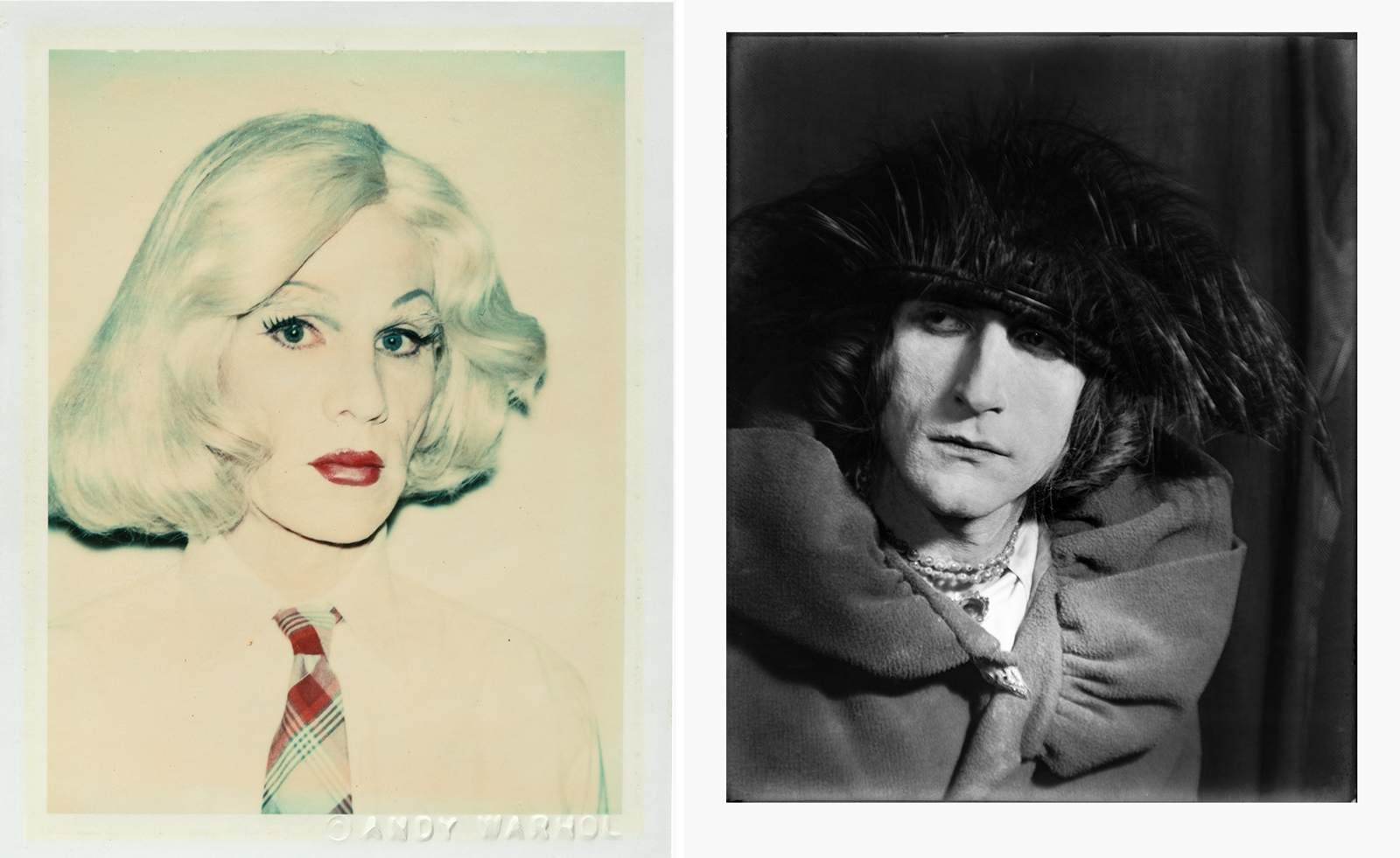 From Rembrandt to Warhol, a Paris exhibition asks: what do artists wear?
From Rembrandt to Warhol, a Paris exhibition asks: what do artists wear?‘The Art of Dressing – Dressing like an Artist’ at Musée du Louvre-Lens inspects the sartorial choices of artists
By Upasana Das
-
 Meet Lisbeth Sachs, the lesser known Swiss modernist architect
Meet Lisbeth Sachs, the lesser known Swiss modernist architectPioneering Lisbeth Sachs is the Swiss architect behind the inspiration for creative collective Annexe’s reimagining of the Swiss pavilion for the Venice Architecture Biennale 2025
By Adam Štěch
-
 A stripped-back elegance defines these timeless watch designs
A stripped-back elegance defines these timeless watch designsWatches from Cartier, Van Cleef & Arpels, Rolex and more speak to universal design codes
By Hannah Silver